1. Early life and background
Jenson Button's early life was marked by a passion for motor racing nurtured by his family, leading him from childhood karting to professional racing.
1.1. Birth and childhood
Jenson Alexander Lyons Button was born on January 19, 1980, in Frome, Somerset, England, and grew up in nearby Vobster, a hamlet in Mells. He is the youngest of four children born to Simone Lyons, who is of half-South African descent, and John Button, a former rallycross driver from London's East End. John Button was well-known in the United Kingdom during the 1970s for racing his Volkswagen Type 1, nicknamed the Colorado Beetle. Jenson's parents met in Newquay at a young age and later reunited after a musical concert at Longleat. According to John, Jenson was named after his Danish friend and rallycross opponent, Erling Jensen, with the spelling changed from "e" to "o" to differentiate it from Jensen Motors. Simone, however, recalls naming him Jenson after seeing a Jensen sports car and thinking the altered spelling would be "more mannish."
Button enjoyed racing from an early age, often racing his BMX bike with friends after school. He began watching Formula One (F1) motor racing with his father around the age of five or six. He greatly admired four-time world champion Alain Prost for his calm personality and intellectual approach to driving. After his parents divorced when he was seven, he and his three elder sisters-Tania Katrina (born 1967), Samantha Chantal (born 1970), and Natasha Michelle (born 1970)-were raised by their mother in Frome.
1.2. Education
Button attended Vallis First School, Selwood Middle School, and Frome Community College. His burgeoning karting career significantly limited his time for formal education, and he ultimately left school with only one GCSE. A notable anecdote from his youth is that he failed his first driving test for attempting to drive between two cars on a narrow road.
1.3. Early racing career
Jenson Button's early racing activities laid the foundation for his professional career, starting with karting and progressing through junior formula categories.
1.3.1. Karting career
Button's entry into competitive motorsport began in 1987 when, at seven years old, his father gave him a 50cc motorcycle for his birthday. However, he quickly discarded it, wanting more speed, which would have required his father to remove its restrictor. He also disliked his father's idea of progressing to the 80cc category. John Button, recognizing his son's innate desire for speed, spoke with rallycross driver and Ripspeed car accessories owner Keith Ripp at an Earl's Court racing car show. Ripp recommended purchasing a Zip go-kart suitable for the newly established Cadets class, designed for karters aged eight to twelve. Button received the kart as a Christmas present in 1987 and began competitive karting at the Clay Pigeon Raceway in May 1988, aged eight, after repeated inquiries from club members to his father about when he would start racing. To fund his son's burgeoning karting career, John Button sold most of his possessions and opened a shop.
Initially, Button's father required him to drive on slick tyres on a wet track to teach him car control on sodden surfaces. He taught him basic driving techniques by standing at a corner and pointing to where his son should brake. In 1989, at age nine, Button won the British Super Prix. Midway through that year, his father discussed progressing to the club level, as others noticed Button's competitive spirit, which interested the young driver. In 1991, Button achieved a remarkable feat, winning all 34 races of the British Cadet Kart Championship and securing the title with team Wright Karts. After this success, Button informed his father of his ultimate objective: to compete in Formula One. He was given a map to chart his progress in karting, and they agreed to give each other more autonomy. Button was mentored by mechanic Dave Spencer, who coached him as he transitioned from the Cadets to Juniors class. Spencer advised him to adopt a more aggressive, less smooth driving style for the more powerful Junior karts and also taught him how to manage tire condition to maintain grip.
Further successes followed, including three British Open Kart Championship victories. A period of sub-par performances in 1992 led Button to doubt his ability to win, but after dismissing a suggestion for a two-month break from karting, he expressed his desire to continue. The family sought advice from Spencer, who, along with Button's father, constructed his karts and even influenced his school headteacher to adjust his fitness regime, requiring him to avoid unhealthy beverages. Spencer also helped Button observe and concentrate on the driving techniques of other karters. This mentorship continued until Spencer's youngest son, Danny, tragically died in a multi-kart accident in December 1994.
In 1994, Button finished fourth in the RAC British Junior Championship, losing a title opportunity due to a series of accidents. He joined the Birel team for that year's Junior Intercontinental A European Championship and raced professionally in the Junior Intercontinental A Italian Winter Championship. At age 15, he became the youngest runner-up of the Formula A World Championship. In 1996, Button signed to drive Tecno-Rotax karts for Team GKS, placing fifth in the European Formula A Championship, third in the Formula A World Cup, and third in the American Championship. In 1997, his team moved him to the top-level Formula Super A karting class. Button won the Ayrton Senna Memorial Cup for finishing second in the 1997 Japanese World Cup and became the youngest driver and first Briton to claim the European Super A Championship. He also finished as runner-up in the Winter Cup before the European Super A Championship.
1.3.2. Junior formula career
At 18, Jenson Button transitioned into single-seater car racing after his mentor, Paul Lemmens, discussed him with racing manager and former driver Harald Huysman. Button was signed to the managerial stable of businessman David Robertson and Huysman, who secured sponsorship for him. This arrangement stipulated that Button would pay 35 percent of his future income to both men. Robertson arranged for Button to test a Carlin Motorsport Dallara F3 Mugen-Honda car at the Pembrey Circuit, where he quickly adapted to the more powerful vehicle and its extra downforce. While Huysman and Robertson initially wanted Button to enter Formula Three (F3), Button felt his inexperience in car racing would make him uncompetitive immediately, so he opted for Formula Ford for the 1998 season instead.
In 1998, driving a Haywood Racing Mygale SJ98 car, Button clinched the British Formula Ford Championship with nine victories and triumphed in the season-ending Formula Ford Festival at Brands Hatch. He also finished as runner-up in the European Formula Ford Championship with one victory from four races, finishing behind future Indianapolis 500 winner Dan Wheldon. At the end of 1998, Button received the annual Autosport BRDC Award, which included a test drive in a McLaren MP4/14 F1 car in November 1999.
Huysman and Robertson then sought an F3 seat for Button. They approached Promatecme team owner Serge Saulnier, who initially hesitated to sign Button because he was not part of Renault's driver academy. However, additional lobbying from Mygale and Lemmens convinced Saulnier to offer Button a test at the Circuit de Nevers Magny-Cours in France. Button impressed Saulnier and accepted his offer to drive for Promatecme. Saulnier instructed Button on the intricacies of F3 car downforce and how to maintain it.
Button competed in the British Formula 3 International Series in 1999, driving a slightly underpowered Renault-Dallara F399 car compared to the Mugen-Honda engine. He received guidance from trainer-physiotherapist Josef Leberer. Among more experienced racers, Button secured three victories-at Thruxton, Pembrey, and Silverstone-to finish the season as the top rookie driver and third overall behind Mark Hines and Luciano Burti. In international F3 races, he finished fifth in the Marlboro Masters and a close second in the Macau Grand Prix, losing by a mere 0.035 seconds to Darren Manning. He also secured a second-place finish in the Korea Super Prix.
After the season, Button had to decide on his future. He did not wish to spend another year in F3 and twice tested a higher-tier Formula 3000 (F3000) car with both the Super Nova Racing and Fortec Motorsport teams at the Jerez circuit in Spain. He found these cars somewhat heavy and disliked their sequential gearbox, which forced him to drive aggressively. During this period, Williams Grand Prix Engineering founder Frank Williams showed interest in Button's talent after observing him at the FIA Gala Dinner.
2. Formula One career
Jenson Button's Formula One career spanned 18 seasons from 2000 to 2017, culminating in a dramatic World Championship victory and numerous Grand Prix wins across multiple teams.
2.1. Williams (2000)
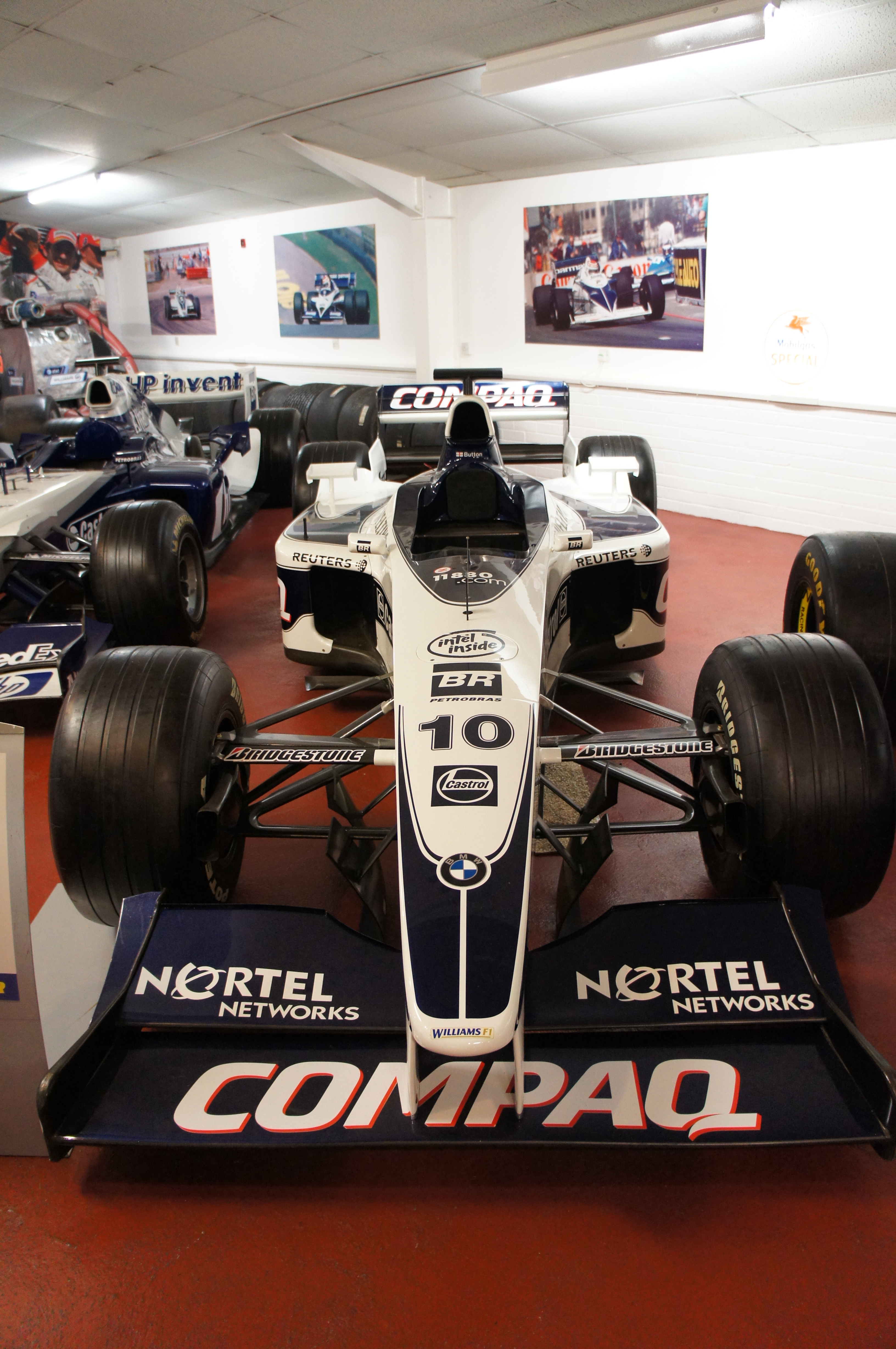
In November 1999, Jenson Button received his McLaren test prize at the Silverstone club circuit, driving a MP4/13 car. He greatly impressed team owner Ron Dennis. Subsequently, he also tested for the Prost team at the Circuit de Catalunya, after team owner Alain Prost, impressed by Button's ability, invited him to test. Prost offered Button a drive at his F3000 squad before suggesting he become his F1 team's test driver for one season to prepare for competitive driving. However, Button did not commit, as Prost had not adequately prepared to fulfill the promise of an F1 seat. Huysman and Robertson, Button's managers, declined Dennis's offer for Button to join the McLaren team and a seat from Jaguar chairman Jackie Stewart.
A vacant race seat became available at the Williams team following the departure of two-time CART champion Alessandro Zanardi. Other contenders for the seat included sports car driver Jörg Müller and Japanese Formula Three champion Darren Manning. On December 24, 1999, team founder and principal Frank Williams telephoned Button, who initially thought it was a joke, and asked if he was ready to drive in F1. Button, being modest, said no, but his father instructed him to tell Williams that he was indeed ready. Button then met with Williams and BMW motorsport director Gerhard Berger, and a 'shoot-out' test was arranged between Button and F3000 racer and test driver Bruno Junqueira at Jerez. They drove a Williams FW21B car that had been modified with a BMW engine. Button ultimately secured the drive, despite the majority of the team's engineers preferring Junqueira. This made him Britain's youngest-ever F1 driver at the time, surpassing the previous record held by Stirling Moss. As Button did not hold a FIA Super Licence, FIA president Max Mosley required him to complete 186 mile (300 km) of testing on two consecutive days and secure support from 18 of the 26 members of the F1 Commission. Despite these requirements, the FIA chose to issue him with a super licence. Button also worked with a physiotherapist to build his strength to handle an F1 car.
Button's F1 debut came at the 2000 Australian Grand Prix. Although he qualified 21st, he showed promise in the race, climbing several positions before retiring on lap 46 due to an engine failure. In the season's second race in Brazil, a sixth-place finish made him the youngest driver in history to score a point in Formula One, a record he held until Max Verstappen in 2015. In his first six races, he outqualified his teammate Ralf Schumacher twice and consistently demonstrated competitive pace. However, Williams had initially intended to use Button only until they could exercise their option to acquire the highly rated Juan Pablo Montoya from his contract at Chip Ganassi Racing. A dip in Button's form, combined with Montoya's victory in the 2000 Indianapolis 500, led to Montoya being announced as his replacement midway through the season. Williams opted not to sell Button's contract outright, retaining the right to recall him in 2003, and instead sent him to Benetton Formula on a two-year loan.
Button's best qualifying performance of the season was third place at the Belgian Grand Prix at Spa-Francorchamps, and his best race result was fourth in the German Grand Prix. Despite early concerns about his inexperience, he made relatively few errors during the season. The most notable mistake occurred at the Italian Grand Prix at Monza, where, under safety car conditions, Button swerved to avoid a bunched-up pack and crashed into a barrier, resulting in his retirement. He finished his debut season in eighth place in the Drivers' Championship with 12 points and was awarded the Autosport Rookie of the Year and F1 Racing Rookie of the Year titles.
2.2. Team Enstone (2001-2002)
Jenson Button's time with the Enstone-based team saw him endure a difficult period with Benetton before a more competitive year under the Renault banner, ultimately leading to his departure.
2.2.1. Benetton (2001)
For the 2001 season, Jenson Button partnered with experienced Italian driver Giancarlo Fisichella at Benetton, a team recently acquired by Renault. The Benetton B201 proved to be a highly uncompetitive car, hampered by a notable lack of power steering and insufficient horsepower compared to faster rivals. This was compounded by a lack of pre-season testing, contributing to Button being consistently outperformed by his teammate. Despite Fisichella's single third-place podium finish in the Belgian Grand Prix, Button struggled significantly with the car's handling throughout the year. He finished 17th in the Drivers' Championship with a total of only two points, which he secured with a fifth-place finish at the German Grand Prix.
His poor form and the stark contrast with his strong debut season led to widespread speculation that he might be replaced before the year concluded. Team principal Flavio Briatore publicly stated, "Either he shows he's super-good or he leaves the top echelon of drivers," and reportedly offered Button the option to leave the team. Briatore believed that Button's inexperience was evident, as he struggled to help the team develop a competitive car. This lack of success, coupled with an increasingly public and extravagant lifestyle, led some press publications to label him as a "playboy".
2.2.2. Renault (2002)
In 2002, Benetton was officially rebranded as the Renault F1 Team, and Jarno Trulli joined the team to partner Button, replacing Giancarlo Fisichella. Determined to improve his public image and performance, Button significantly altered his social life habits during the pre-season interval, dedicating more time to training. He also separated from his former managers, Robertson and Huysman, to join John Byfield's sports management stable, a move encouraged by Flavio Briatore. In late 2001, Briatore invited Button to spend ten days at a ranch in Kenya, where he engaged in physical training to resolve persistent shoulder and back problems that had hindered him in 2001. Button invested considerable effort in working closely with his engineering team, feeling a greatly improved understanding developing between them, which made him "very confident" for the upcoming season.
Button's season started strongly. At the second race in Malaysia, he was poised for his first career podium finish, running in third place, before a rear suspension problem on the final lap caused him to drop to fourth. His performances were vastly improved from 2001, partly due to the car now featuring power steering and launch control. Although he was often outqualified by Trulli, Button consistently demonstrated superior race pace, allowing him to outscore his more experienced teammate by the season's end. Despite Button's strong performances and his expressed desire to remain with Renault, he was informed by Briatore via telephone that test driver Fernando Alonso would replace him for 2003. Briatore faced criticism for this decision, famously stating, "time will tell if I am wrong," and he would later accuse Button of being a "lazy playboy." In July, Button secured a two-year contract with British American Racing (BAR), with an option for an additional two years, to replace the departing Olivier Panis. He partnered with 1997 world champion Jacques Villeneuve. A significant factor in his decision was the opportunity to work with David Richards, the BAR team principal, and he was impressed with the team's long-term program. Button finished the 2002 season in seventh place in the Drivers' Championship with 14 points.
2.3. Brackley-based teams (2003-2009)
Jenson Button's career with the Brackley-based teams, transitioning from BAR to Honda and eventually to Brawn GP, marked a period of significant growth and culminated in his first Formula One World Championship title.
2.3.1. BAR (2003-2005)
Jenson Button's tenure at British American Racing (BAR) was characterized by initial team dynamics challenges, a breakout season in 2004, and recurrent contract disputes.
2.3.2. Honda (2006-2008)
Jenson Button's years with the Honda works team were a mix of personal triumph, including his maiden Grand Prix victory, followed by a period of struggle and ultimately Honda's withdrawal from Formula One.
2.3.3. Brawn GP (2009)
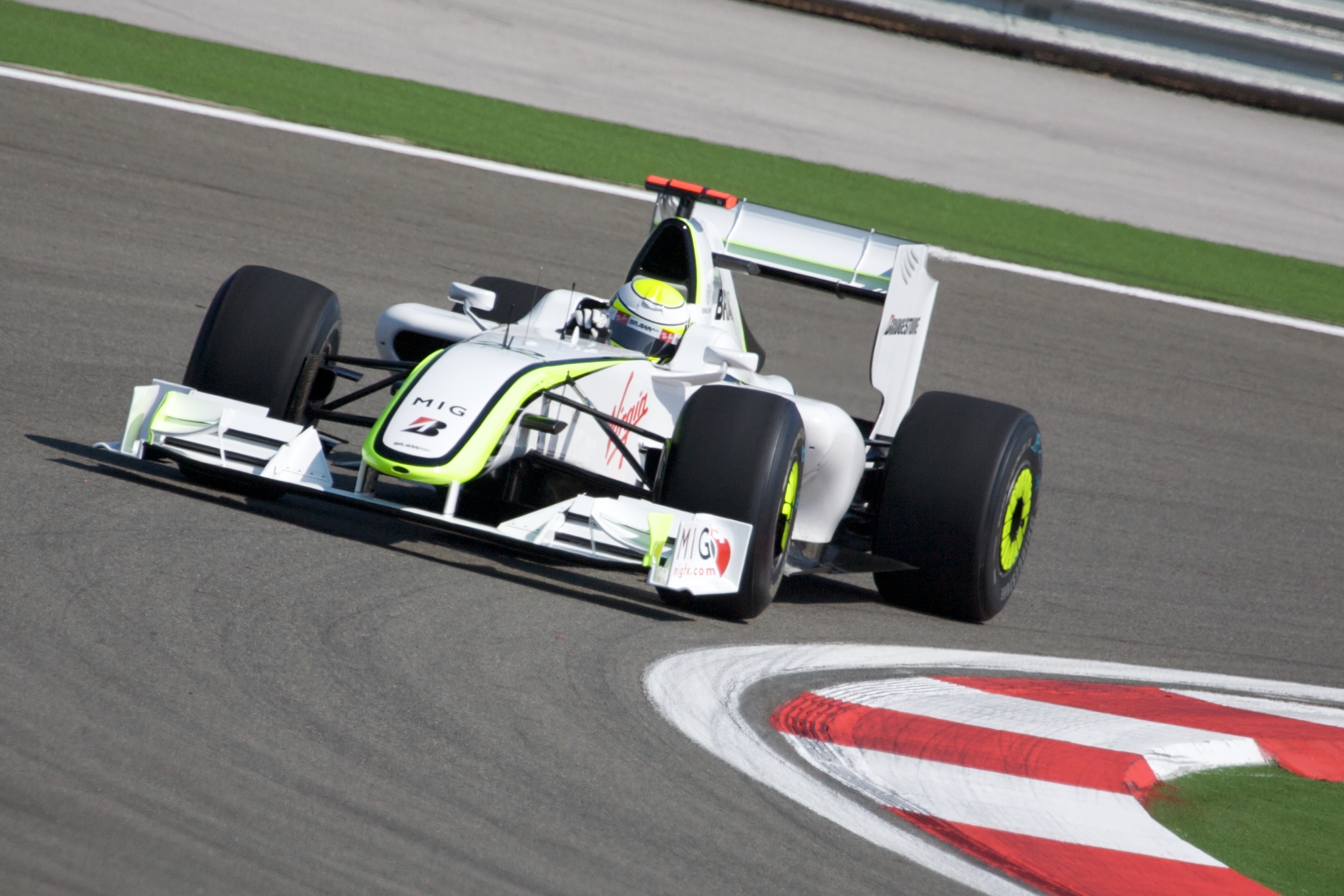
In early March 2009, just weeks before the start of the season, Ross Brawn orchestrated a management buyout of the former Honda team for a nominal fee, renaming it Brawn GP. Jenson Button quickly signed a contract to drive for the new team in 2009, agreeing to a pay cut as part of the deal. Despite being installed by bookmakers as a 100-1 outsider for the championship, Button's Brawn BGP 001 car proved unexpectedly quick and reliable in pre-season testing in Europe. This was largely attributed to its highly efficient aerodynamic package, a powerful Mercedes-Benz V8 engine, and grippy slick tyres. The car's seat was also lowered to enhance his comfort, which played a role in his immediate success.
Button's season started with a dominant run, as he won six of the first seven races, securing four pole positions in the process. His early success was largely due to the Brawn car's innovative double diffuser design, which, along with similar designs by the Toyota and Williams teams, provided a significant aerodynamic advantage over other competitors. This extraordinary achievement saw him match records set by former world champions like Alberto Ascari, Juan Manuel Fangio, Jim Clark, and Michael Schumacher. However, once major teams introduced their own reconfigured diffusers, Button's dominance waned. In the subsequent ten races, he averaged a sixth-place finish, scoring 35 points compared to the 61 he had amassed in the first seven. This shift was partly attributed to the team's limited budget, with only 10 percent of its allocated 7.00 M GBP being spent on car development, and Button's smooth driving style, which sometimes prevented him from generating sufficient heat into the tires in colder weather conditions.
At the Brazilian Grand Prix, Button faced a challenging qualifying session due to a poor choice of tires in the wet weather, which left him starting from 14th position. However, his championship campaign received a boost when rival Sebastian Vettel qualified 16th, though his teammate and closest rival, Rubens Barrichello, secured pole. In the race, Button executed a brilliant performance, making several key overtakes and benefiting from a safety car period. He ultimately finished fifth, securing enough points to clinch the World Drivers' Championship with one round remaining. With 169 career starts before claiming the title, Button had the second-highest number of race starts before becoming World Champion, only surpassed by Nigel Mansell (with 176 starts). His success also played a crucial role in Brawn GP securing the World Constructors' Championship in their debut season. At the final race of the season, the Abu Dhabi Grand Prix, Button qualified behind Barrichello once more but finished on the podium in third position, celebrating his championship triumph.
In the off-season, Ross Brawn and team principal Nick Fry informed Button of their desire for him to sign a contract extension and be partnered with Nico Rosberg. Button, however, sought a firm commitment to car development for 2010 and a guarantee of performance close to the 2009 season's success. When Brawn and Fry indicated that Mercedes intended to buy out Brawn GP without securing potential sponsors, Button found the prospect unappealing. He conveyed his desire for a new challenge to his manager, Richard Goodard, setting the stage for his move to McLaren.
2.4. McLaren (2010-2017)
Jenson Button's years with McLaren were a period of significant growth and formidable competition, particularly alongside Lewis Hamilton, and saw him consistently perform at the highest level despite varying car performance.
2.4.1. 2010

Following his championship win, Jenson Button's manager, Richard Goodard, contacted McLaren team principal Martin Whitmarsh to inquire about a drive for Button. Whitmarsh initially doubted Button would leave Brawn GP after their championship success. However, Goodard highlighted McLaren's competitiveness at the end of 2009 and the appeal of partnering with 2008 world champion Lewis Hamilton, which greatly interested Button. Discussions took place at McLaren's headquarters in Woking, leading to a three-year deal soon after. Button stated his motivation for the move was the challenge and motivation from competing alongside Hamilton. Nonetheless, Whitmarsh cautioned both drivers before the season, emphasizing that he would closely monitor any relationship problems between them. Many observers predicted that Button's move to McLaren would be a mistake, with him being overshadowed by Hamilton, but Button soon proved his critics wrong.
Button quickly demonstrated his prowess, winning at the Australian and the Chinese Grand Prix in variable weather conditions, taking the lead in the Drivers' Championship. He then finished second in Turkey after a miscommunication with his team led to an on-track battle with Hamilton for the victory, which subsequently cooled his relationship with Hamilton, who believed McLaren favored Button. He followed this with two more podium finishes and three points-scoring finishes to remain a contender for the championship. Button retired at the Belgian Grand Prix after Sebastian Vettel hit him, puncturing the radiator of his car. A second-place finish at Monza was followed by fourth places in both Singapore and Japan. During the Brazilian Grand Prix weekend, Button and his entourage were threatened by criminals in the favelas on their way back from qualifying at Interlagos; fortunately, no one was harmed during the incident. Button was mathematically eliminated from retaining the title with a fifth-place finish in that race and concluded the 2010 season in fifth place in the championship after securing third in Abu Dhabi.
2.4.2. 2011
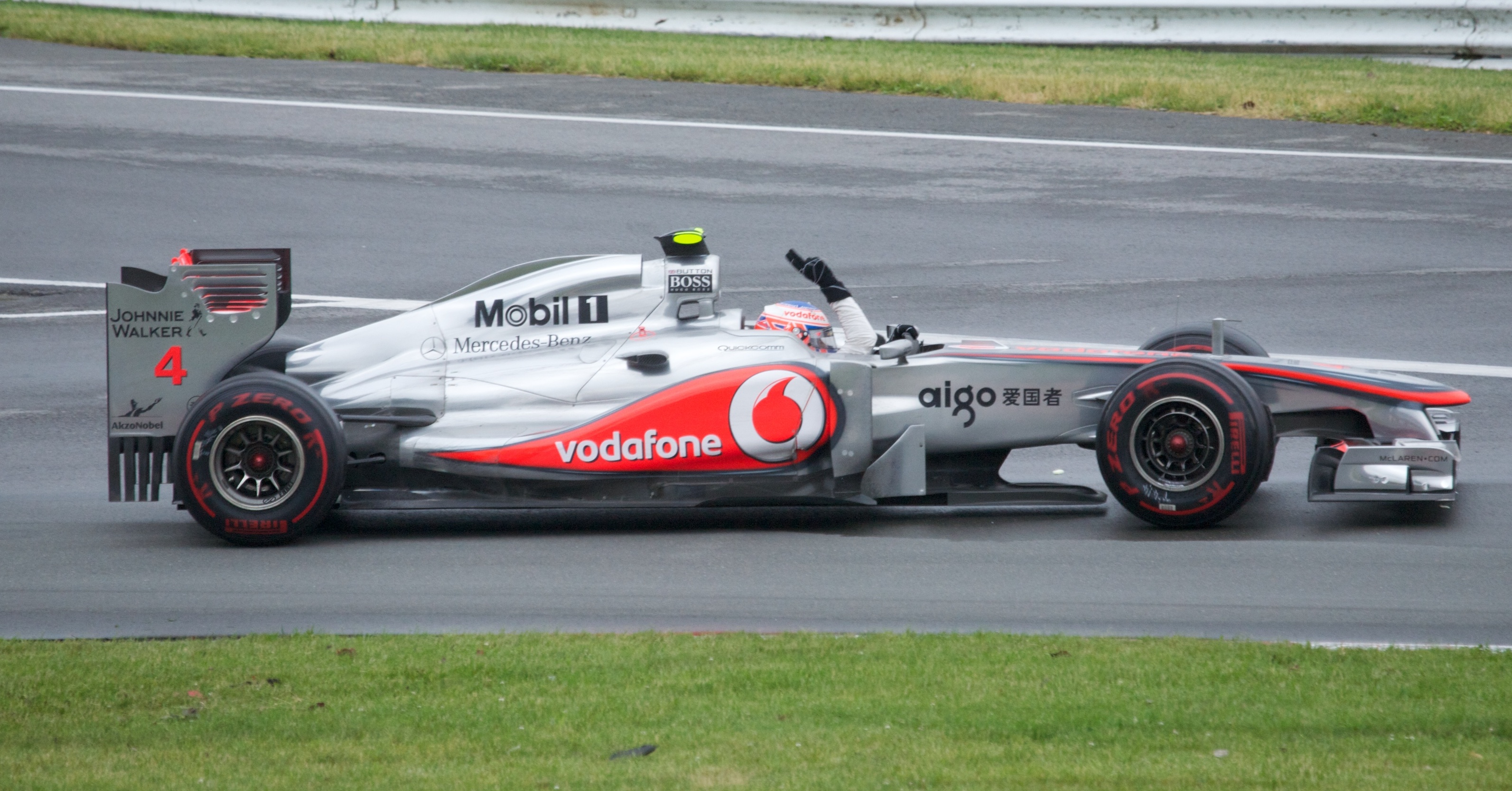
Jenson Button's MP4-26 car for the 2011 season was specifically designed to accommodate his taller frame, incorporating his input from late 2010. Button believed that the introduction of Pirelli tires that season would particularly suit his smooth driving style, and he stated that a world championship victory would make it difficult for him to retire from Formula One.
He began the season with consistent performances, finishing no lower than sixth in the first six races, which included three podium finishes. A standout moment came at the rain-affected Canadian Grand Prix. After two collisions dropped him to the back of the field, Button staged a remarkable comeback, eventually overtaking Sebastian Vettel when the latter ran wide on the slippery track on the final lap to clinch an improbable victory. Button then secured two more wins in similar wet-to-dry conditions at the Hungarian Grand Prix (his 200th F1 race) and the Japanese Grand Prix. However, his results over the course of the season ultimately meant he was mathematically eliminated from championship contention when Vettel secured the title in Japan. Despite this, Button's consistency shone through. He achieved 3 victories and 12 podium finishes, accumulating 270 points to finish as the runner-up in the World Drivers' Championship. Before the Japanese Grand Prix, Button signed a multi-year extension to his contract with McLaren.
2.4.3. 2012
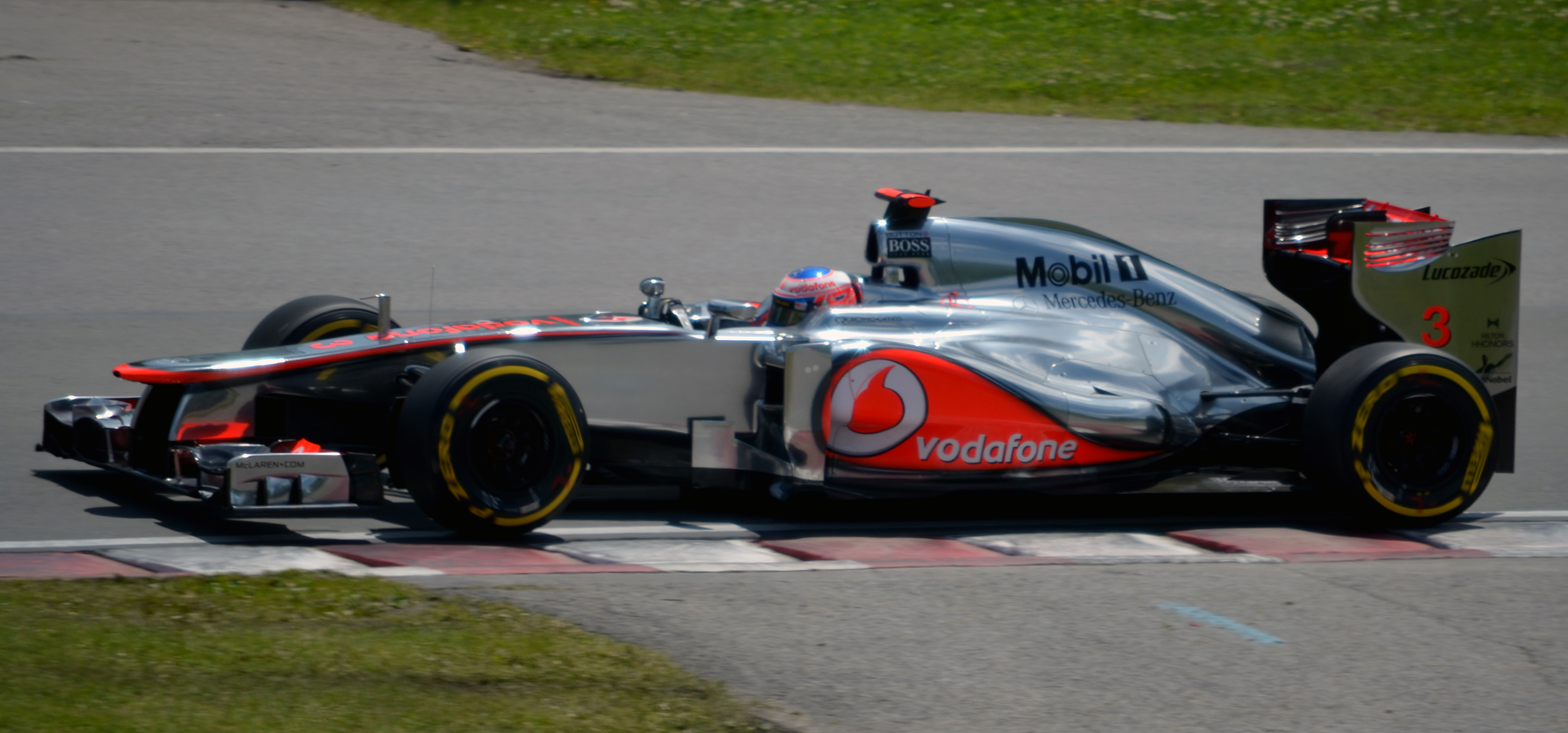
McLaren team principal Martin Whitmarsh expressed his desire for Jenson Button to remain at McLaren for the next three years, even as Button engaged in discussions with Ferrari regarding a race seat for 2013. However, prior to the 2011 Japanese Grand Prix, Button officially signed a three-year extension to his contract with McLaren. While press reports suggested the contract was worth 85.00 M GBP, Button later clarified in his autobiography, Life to the Limit, that this figure was inaccurate.
Button expressed satisfaction with the new MP4-27 car, noting that McLaren had found a regulatory loophole concerning the banning of exhaust gas blowing over parts of the vehicle, which had previously been used to improve downforce. The season began on a high note with a victory at the opening Australian Grand Prix, followed by two second-place finishes at the Chinese and the German Grand Prix, which were highlights of his first half of the season.
However, his overall performance declined across the first seven races due to difficulties generating sufficient temperature and the correct amount of grip into the new Pirelli short-life front tires. This issue was exacerbated by his smooth driving style and his multiple attempts to resolve the problem by switching brake materials. To adapt, Button made significant changes to his car's setup and adjusted his driving to better manage tire temperature for improved performance. The remainder of Button's season saw him secure impressive wins in Belgium and Brazil, alongside top-five finishes in five of the next seven rounds. He concluded the 2012 season in fifth place overall in the Drivers' Championship with 188 points.
2.4.4. 2013
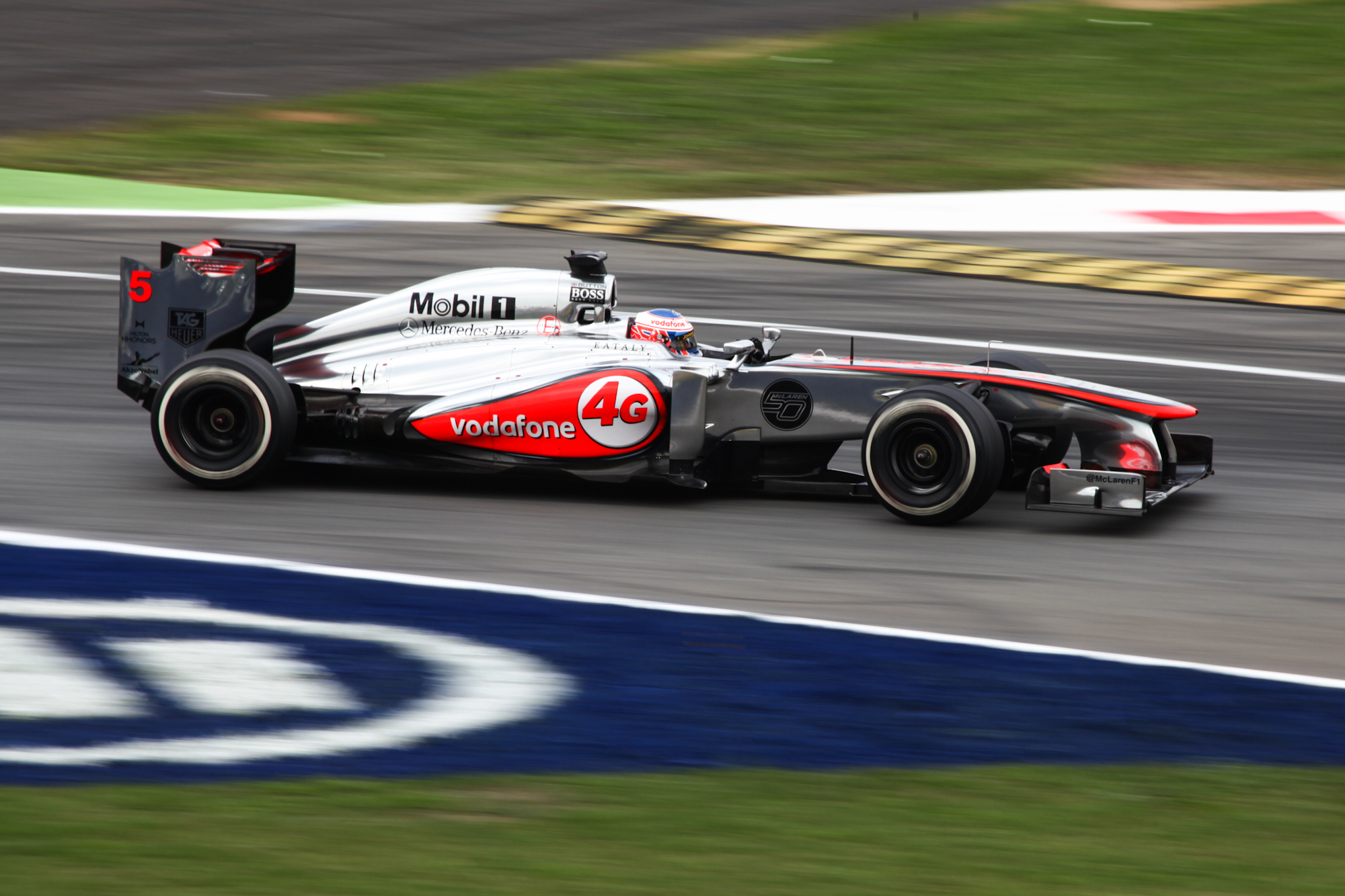
For the 2013 season, Jenson Button was joined at McLaren by Ferrari Driver Academy graduate Sergio Pérez. Their relationship was notably cooler, partly due to Pérez's hasty entry into the team. In March 2013, Button was appointed a director of the Grand Prix Drivers' Association (GPDA). McLaren's development strategy for the MP4-28 car was to build it from scratch rather than in anticipation of the 2014 regulation changes. This approach resulted in Button driving an unstable car that suffered from significant understeer, a lack of downforce, and severe tire degradation.
After finishing ninth at the season-opening Australian Grand Prix, McLaren introduced components from the previous MP4-27 onto the MP4-28, but these changes had no significant effect. Consequently, Button continued to achieve sub-par results throughout the season, with his best finish being a fourth place at the season-ending Brazilian Grand Prix. Notably, Button broke his knuckle at a party before the Japanese Grand Prix but still competed in the race with a strap, making the services of simulator driver Oliver Turvey and Kevin Magnussen unnecessary. He also expressed annoyance early in the season due to aggressive driving from his teammate Pérez in Bahrain and Monaco. Button finished the 2013 season ninth overall in the Drivers' Championship with 73 points.
2.4.5. 2014-2015
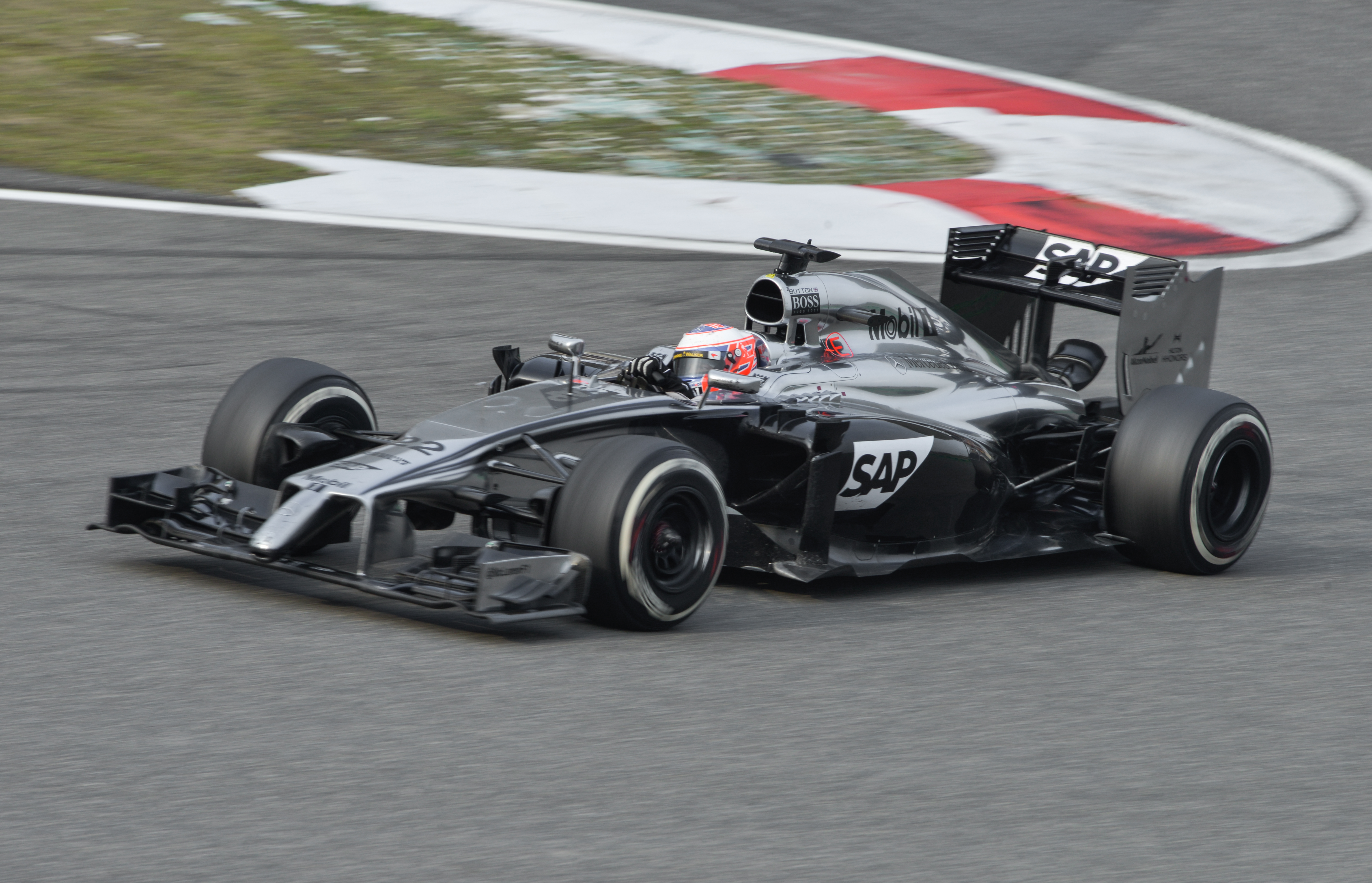
In September 2013, Jenson Button activated the terms of his contract to remain with McLaren for 2014. However, he admitted to considering taking a sabbatical from Formula One following the unexpected death of his father in Monaco in January 2014. For the 2014 season, Button was partnered with rookie Kevin Magnussen, with whom he was able to build a good rapport. The MP4-29 car proved challenging, characterized by understeer stemming from a lack of front downforce and an unstable rear.
Button secured his final career podium at the season-opening Australian Grand Prix, where he was promoted to third place after Red Bull Racing driver Daniel Ricciardo was disqualified for a fuel flow consumption infringement, and his team's subsequent appeal against the decision was lost. Throughout the season, Button achieved four fourth-place finishes and scored points on seven other occasions, ending the 2014 season in eighth place in the Drivers' Championship with 126 points. He notably outqualified Magnussen ten times and scored twice as many points, which played a crucial role in securing his seat at McLaren for the following season amidst rumors that Fernando Alonso would join as Magnussen's teammate in 2015.
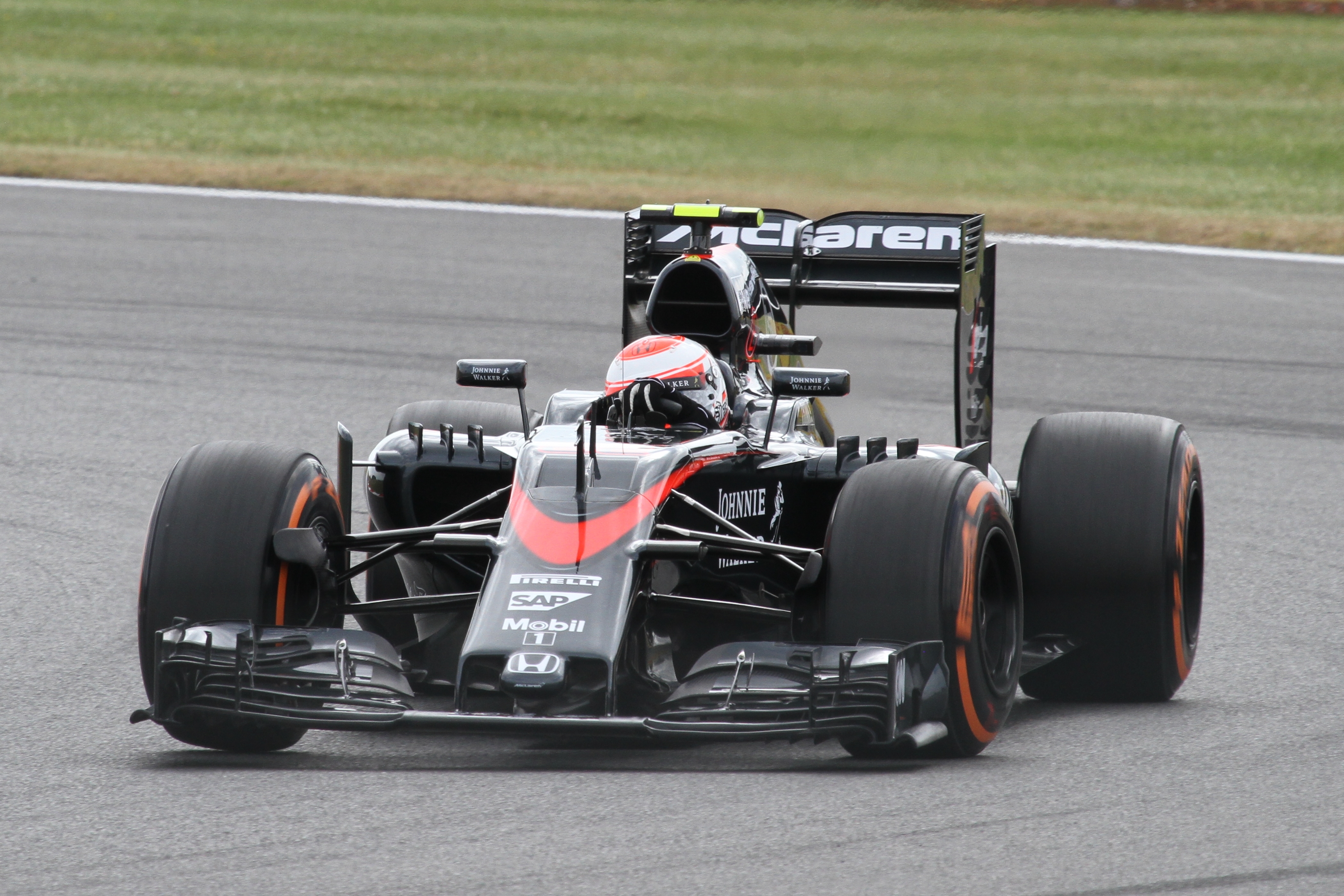
As the 2014 season concluded, Button became increasingly unenthusiastic about Formula One, and the press widely speculated about his future in the sport, fueled by rumors of Alonso joining McLaren as Magnussen's teammate for 2015. Button, despite feeling insecure about his career, expressed his desire to remain at McLaren and focused on the present rather than future uncertainties. Ron Dennis, McLaren's CEO, initially opposed Button's retention, but fellow team shareholder Mansour Ojjeh advocated for Button to stay over Magnussen after reviewing the situation. Negotiations between Button, McLaren Racing Director Éric Boullier, and Ron Dennis concluded on December 10 with an agreement for Button to continue racing. He agreed to a pay cut, with his contract including an option for a second year, allowing either McLaren or Button to activate clauses to terminate the contract after the season if desired.
The 2015 season proved challenging for Button due to an unreliable and underpowered Honda engine that severely lacked straight-line speed. He managed only four top-ten finishes, with a best result of sixth at the United States Grand Prix. Button rarely managed to progress beyond the first qualifying session and finished 16th in the Drivers' Championship with 16 points.
2.4.6. 2016-2017
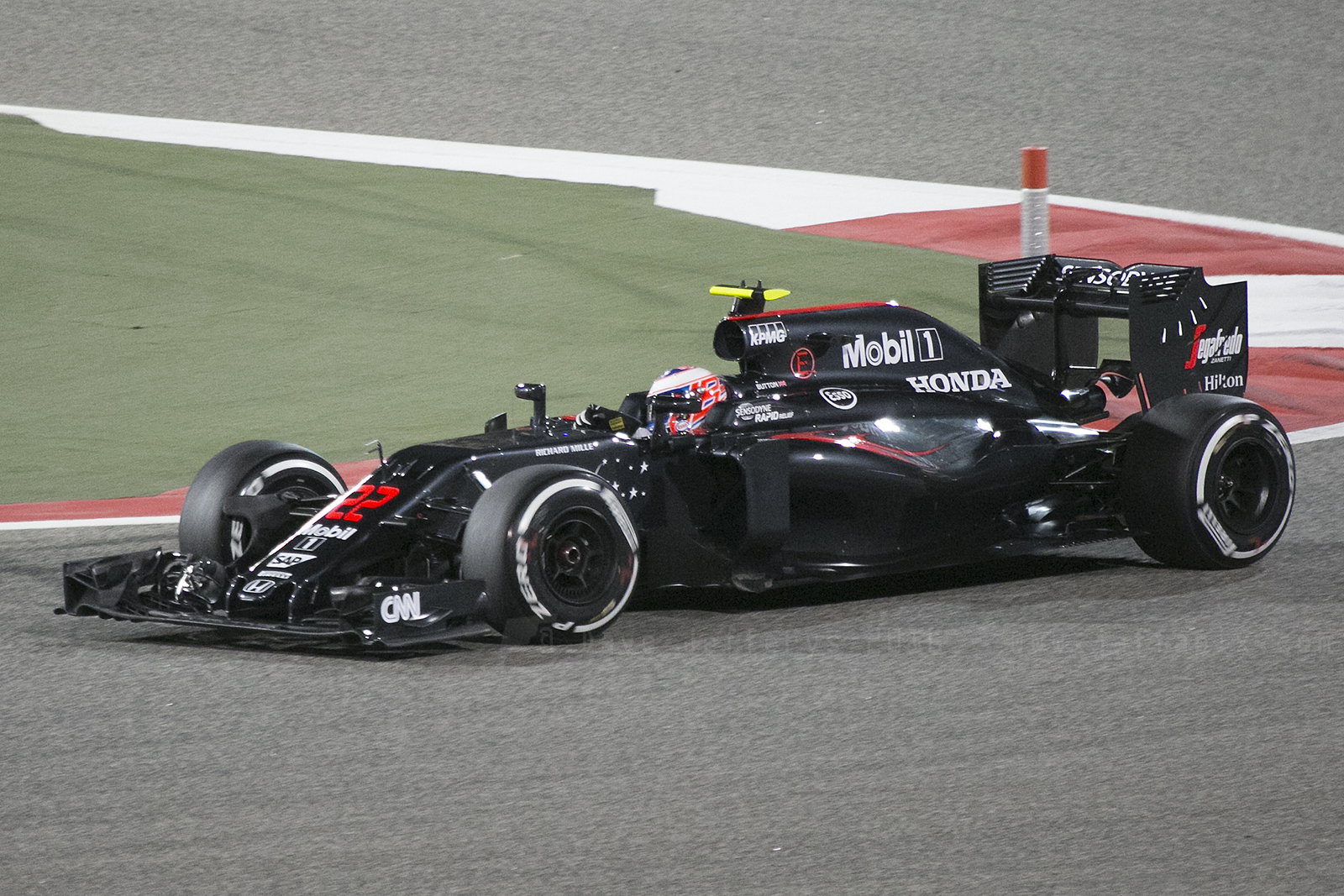
Jenson Button was retained by the McLaren team for the 2016 Formula One season following contractual discussions with Ron Dennis and meetings with aerodynamics and engineers at the McLaren Technology Centre (MTC). His decision to stay resulted in a 50 percent pay rise. He had briefly considered returning to the Williams team but ultimately decided against it. While his car's new Honda engine was more powerful and allowed him to contend for points-scoring finishes, reliability issues continued to plague both him and McLaren. He completed 15 of the 21 races that year, achieving a season-high third-place qualifying position at the Austrian Grand Prix, which was the highest start for the McLaren-Honda partnership. Button went on to finish that race in a season-best sixth place. However, he was unable to finish higher than eighth in subsequent races and concluded his full-time Formula One career with a suspension failure at the season-ending Abu Dhabi Grand Prix. Button finished 15th in the Drivers' Championship with 21 points, outperforming teammate Fernando Alonso in five races and outqualifying him on four occasions.
Before the Belgian Grand Prix, Button informed Ron Dennis of his plan to retire after the season. Dennis, surprised by the news, asked Button to wait before returning for further discussion, but Button insisted he had already made his decision. Dennis then suggested Button take a sabbatical and offered him a role as an ambassador for McLaren, allowing him to mull over his retirement decision while resting. In this new capacity, Button would work in the team's simulator at the MTC, represent them at sponsor functions, and contribute to car development. Button was officially retained by McLaren as a reserve driver, with an option to return to full-time racing for the team in 2018 if both parties agreed. He was replaced as a GPDA director by Romain Grosjean.
In April 2017, McLaren Racing Director Éric Boullier requested Button to drive in place of Fernando Alonso at the Monaco Grand Prix, as Alonso was competing in the Indianapolis 500. Button agreed after his manager, Richard Goodard, confirmed that he was contractually bound to fulfill the commitment. For preparation, he opted to use the team's simulator instead of testing in Bahrain, believing he would gain nothing by not driving on a narrow street circuit. In the race, he was forced to retire late after a collision with Sauber driver Pascal Wehrlein damaged his car. Button's contract with McLaren expired without renewal at the end of 2017, allowing him to focus on other racing ventures. He was subsequently replaced as McLaren's reserve driver by 2017 FIA Formula Three European champion Lando Norris for 2018. Button concluded his McLaren career as the driver with the second-highest number of race starts for the team, with 136, behind only his compatriot David Coulthard.
2.5. Williams senior advisor (2021-)
In January 2021, Jenson Button formally rejoined his former team, Williams, as a senior advisor under a multi-year agreement. In this role, he works with Williams's race drivers and Williams Academy drivers both on-track and at the team's headquarters. He also undertakes ambassadorial duties for the team. Button's focus is on the entire team rather than one specific department. Initially, his ability to be physically present at Williams's facilities was limited due to travel restrictions from the United States and strict COVID-19 protocols that required him to remain within the Sky Sports broadcasting bubble. However, he is expected to spend more time with the team as these restrictions ease.
3. Post-Formula One racing career
After concluding his full-time Formula One career, Jenson Button diversified his racing activities, competing in various international series and endurance events, showcasing his versatility across different motorsport disciplines.
3.1. Super GT career
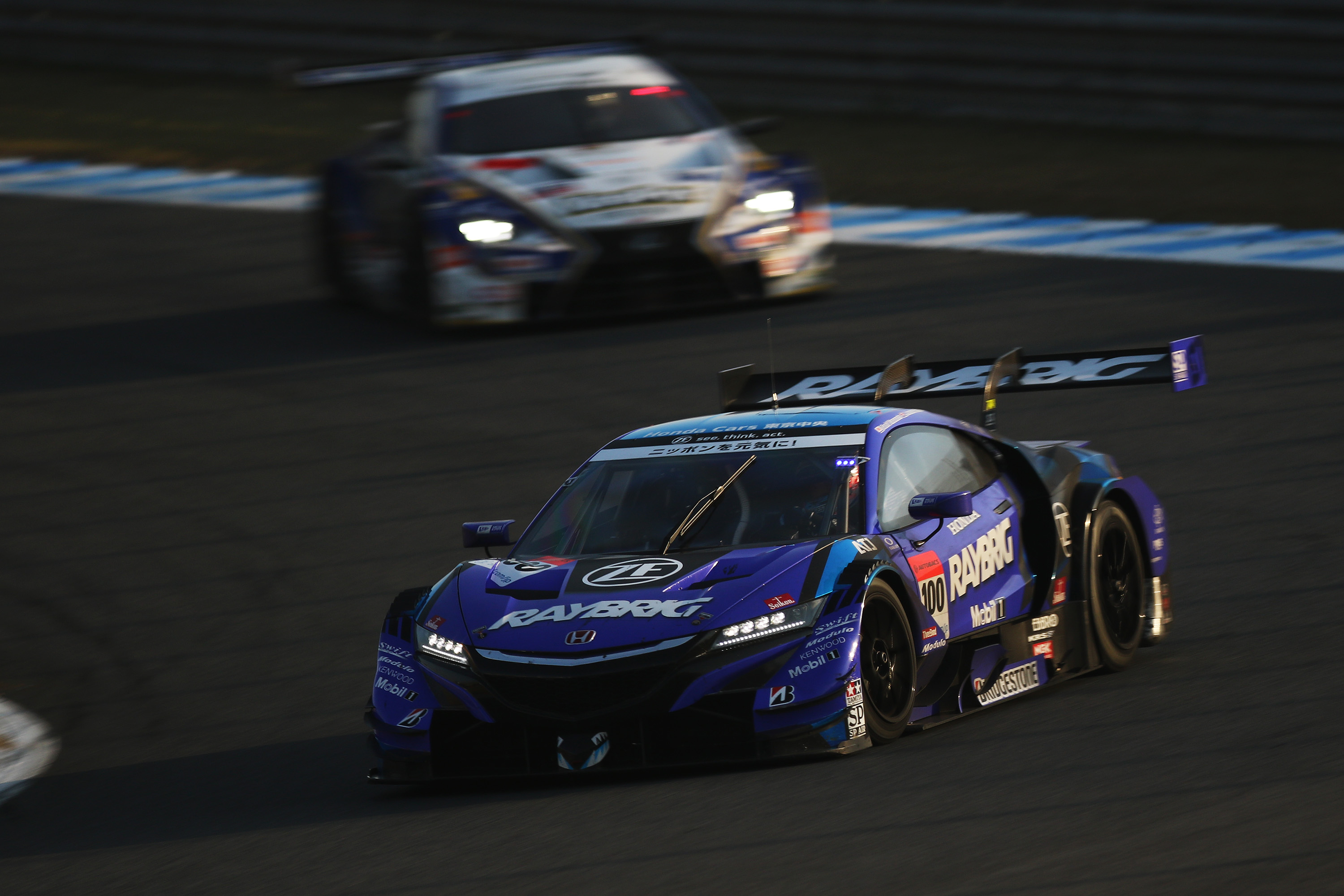
Jenson Button's interest in the Japanese Super GT series began around 2011, and discussions with Honda eventually led to his series debut at the 2017 Suzuka 1000km. He competed in a NSX-GT for Team Mugen, sharing the car with teammates Hideki Mutoh and Daisuke Nakajima. Despite having virtually no prior experience with closed-cockpit racing cars, Button adapted quickly, taking on the crucial Q1 qualifying session. The trio finished 12th in the race, hampered by two penalties and two tire punctures. Button also considered racing as a third driver for Acura Team Penske's IMSA SportsCar Championship team, but this opportunity did not materialize.
Button committed to driving the full 2018 Super GT Series season for Team Kunimitsu. He piloted the No. 100 GT500-class Honda NSX-GT alongside Naoki Yamamoto. Button specifically requested a car shod with Bridgestone tires, and Yamamoto was recommended as a teammate due to his English-speaking ability. The team provided significant support to help Button communicate effectively and adapt to the unique culture and demands of the series. Button and Yamamoto secured a victory at Sportsland Sugo and earned two second-place finishes. They entered the season-ending race at Twin Ring Motegi tied on points with the TOM'S duo of Ryō Hirakawa and Nick Cassidy. In a tense finale, Button successfully held off Hirakawa to win the GT500 title by three points, becoming the first rookie champion since Toranosuke Takagi in 2005.
For the 2019 season, Button remained at Team Kunimitsu alongside Yamamoto, driving the renumbered No. 1 Honda. However, the season was incident-filled for the pair: they were taken out of the lead in the opening round at Okayama due to a collision, a mistimed safety car period cost them at the second Fuji race, and a poor tire choice in the rain at Sugo eliminated them from potential victories. Despite these setbacks, the pair achieved two podium finishes at both Fuji rounds and a sixth place at Motegi. They finished eighth in the GT500 Drivers' Championship with 37 points. In October 2019, Button also competed in the final two races of the Deutsche Tourenwagen Masters (DTM) round at the Hockenheimring in his Team Kunimitsu NSX car, participating as Honda's wild card entry. He finished ninth in the first race and 16th in the second. Button did not participate in the "Super GT × DTM Dream Race" at Fuji Speedway, as his contract did not oblige him to do so. He ultimately left Super GT after 2019, citing a desire to avoid frequent flights between the United States and Japan and to explore other racing series.
3.2. Sports car career

Jenson Button made his endurance racing debut at the 1999 Spa 24 Hours, where he shared a BMW Team Raffanelli 320i E46 with David Saelens and Tomáš Enge in the SP class. However, their race ended in retirement after 22 laps due to a fuel tank failure.
Button later agreed to participate in most of the 2018-19 FIA World Endurance Championship season, driving a BR Engineering BR1 car in the Le Mans Prototype 1 (LMP1) class alongside Vitaly Petrov and Mikhail Aleshin for SMP Racing. He missed the season-opening 2018 6 Hours of Spa-Francorchamps due to a Super GT commitment. Making his FIA World Endurance Championship debut at the 2018 24 Hours of Le Mans, the car encountered electronic problems that dropped it down the order before ultimately retiring with an engine failure late in the race, with Button at the wheel. He achieved a fourth-place finish at the 2018 6 Hours of Fuji and a third-place podium at the subsequent 2018 6 Hours of Shanghai. Button's Super GT commitments also led him to miss the 2019 1000 Miles of Sebring and the 2019 6 Hours of Spa-Francorchamps, and he was unable to participate in the 2019 24 Hours of Le Mans because his fiancée was due to give birth to their first child. Brendon Hartley and later Stoffel Vandoorne drove in Button's place for the remainder of the season.
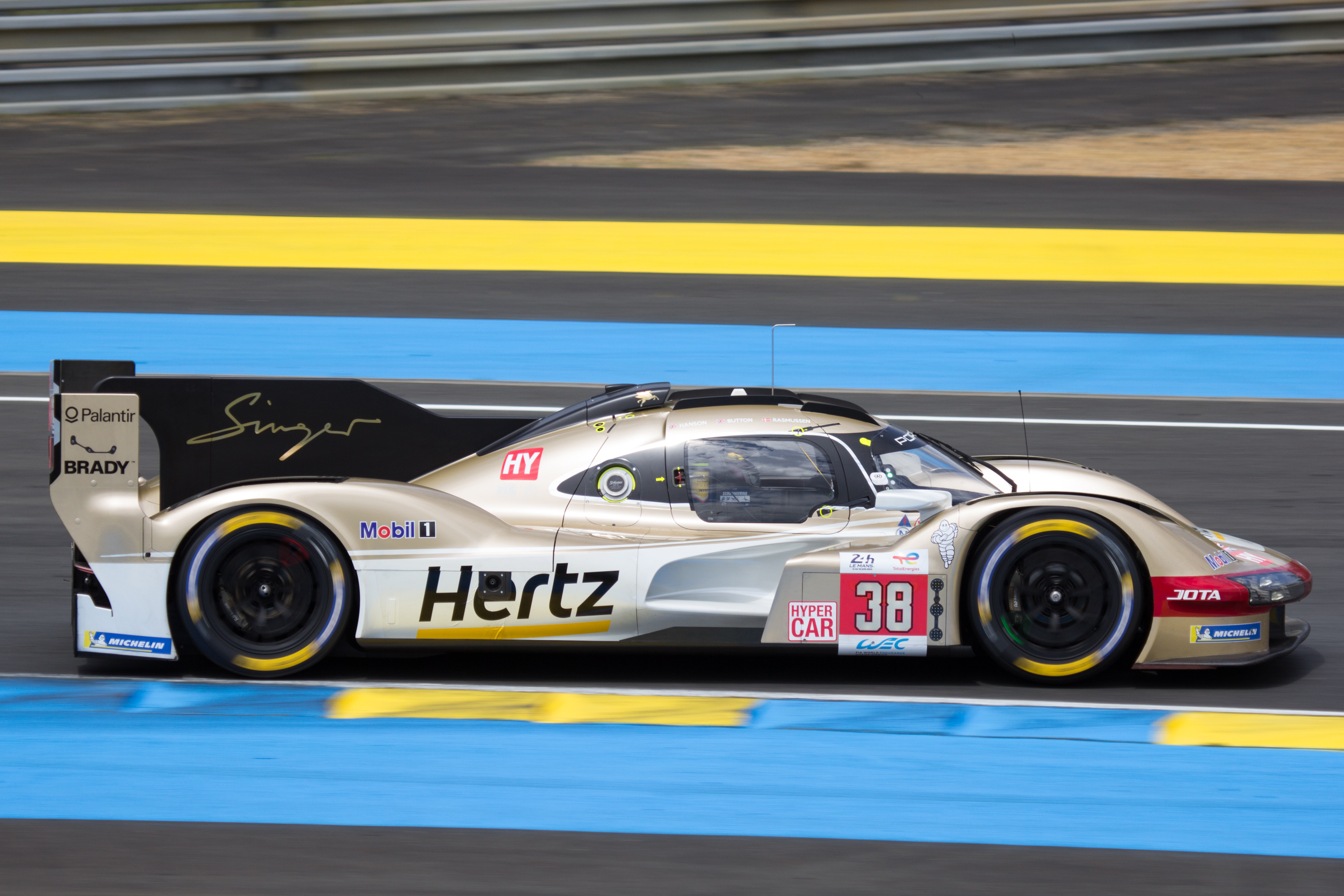
Button made his British GT debut in the 2020 season's final round, the three-hour Silverstone 500, sharing the No. 3 Jenson Team Rocket RJN McLaren 720S GT3 with team co-owner Chris Buncombe. The pair finished the race in 14th position.
He participated in Hendrick Motorsports's NASCAR Next Gen Chevrolet Camaro ZL1 Garage 56 entry alongside sports car driver Mike Rockenfeller and NASCAR racer Jimmie Johnson at the 2023 24 Hours of Le Mans. The trio completed 285 laps, finishing 39th overall despite a driveline fault late in the event. Button also entered the ten-hour 2023 Petit Le Mans (part of the IMSA SportsCar Championship), driving JDC-Miller MotorSports' Porsche 963 alongside Rockenfeller and Tijmen van der Helm, as broadcasting commitments prevented his entry to the Sahlen's Six Hours of The Glen. The car started ninth and finished fifth.
For the 2024 24 Hours of Daytona, Button joined Louis Delétraz, Colton Herta, and Jordan Taylor in sharing Wayne Taylor Racing with Andretti's No. 40 Acura ARX-06 GTP car, finishing third overall. He returned to the FIA World Endurance Championship in 2024, sharing Team Jota's No. 38 Porsche 963 with Phil Hanson and Oliver Rasmussen. Button initially appeared slower than his teammates and seemed frustrated with slower cars until he grew more comfortable by the 24 Hours of Le Mans. He finished the season 19th in the World Endurance Drivers' Championship, achieving five points-scoring finishes, including a season-best result of sixth at the 6 Hours of Fuji.
Button is set to remain at Jota for the 2025 FIA World Endurance Championship and will share the No. 38 Cadillac V-Series.R with Earl Bamber and Sébastien Bourdais in the Hypercar category, following the team's manufacturer change from Porsche to Cadillac.
3.3. Other racing ventures
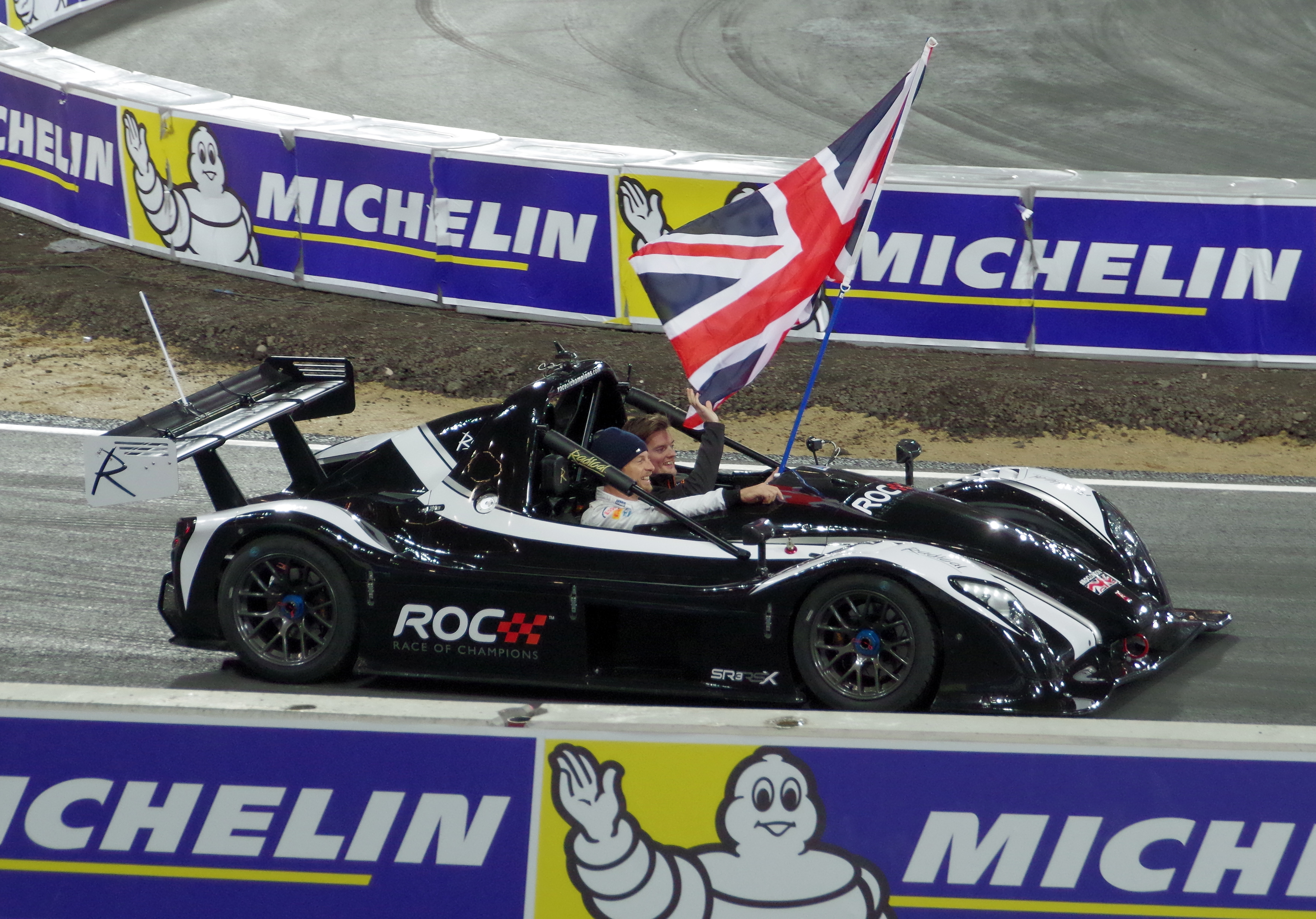
Jenson Button was invited to the Race of Champions six times, participating in 2007, 2008, 2009, 2011, 2015, and 2017. He reached the semi-finals of the Nations Cup with Andy Priaulx for Team Autosport in both 2007 and 2008, and finished second in 2009. His best individual performance in the Race of Champions was reaching the semi-finals in 2009. Notably, Button was replaced by touring car driver James Thompson for the 2006 Race of Champions after sustaining injuries in a karting accident.
In 2019, Button ventured into off-road racing, driving a Rocket Motorsports-entered Brenthel Industries Spec 6100 TT class truck. His co-drivers included Chris Buncombe and managing director Mazen Fawaz. This participation originated when Button told Buncombe that they would race the Baja 1000 as a 40th birthday present for Buncombe, leading them to seek appropriate vehicle components. Navigated by Terry Madden, Button's best finish was no higher than the top 20 in the Mint 400. He experienced retirements in the Vegas to Reno and the Baja 1000, with the latter leaving him and his co-driver stranded in the desert for nearly 17 hours after a differential gear failure.
During the suspension of motor racing due to the COVID-19 pandemic in 2020, Button actively participated in eSports races. In January 2021, Button launched JBXE to compete in the all-electric SUV off-road racing series Extreme E from the 2021 season onwards, serving as both team owner and driver. He stopped driving after the first round, the 2021 Desert X-Prix, to focus on his role as team principal, replacing himself with Kevin Hansen for subsequent rounds. Button also made his first foray into historic racing at the Goodwood Revival in 2021, participating in the Stirling Moss Trophy and the Royal Automobile Club TT Celebration races. He was initially set to drive an FC1-X car for the Xite Energy Racing team in the all-electric Group E category for the 2022-23 season of the off-road Nitro Rallycross series, but he withdrew from the remainder of the season after just one round.
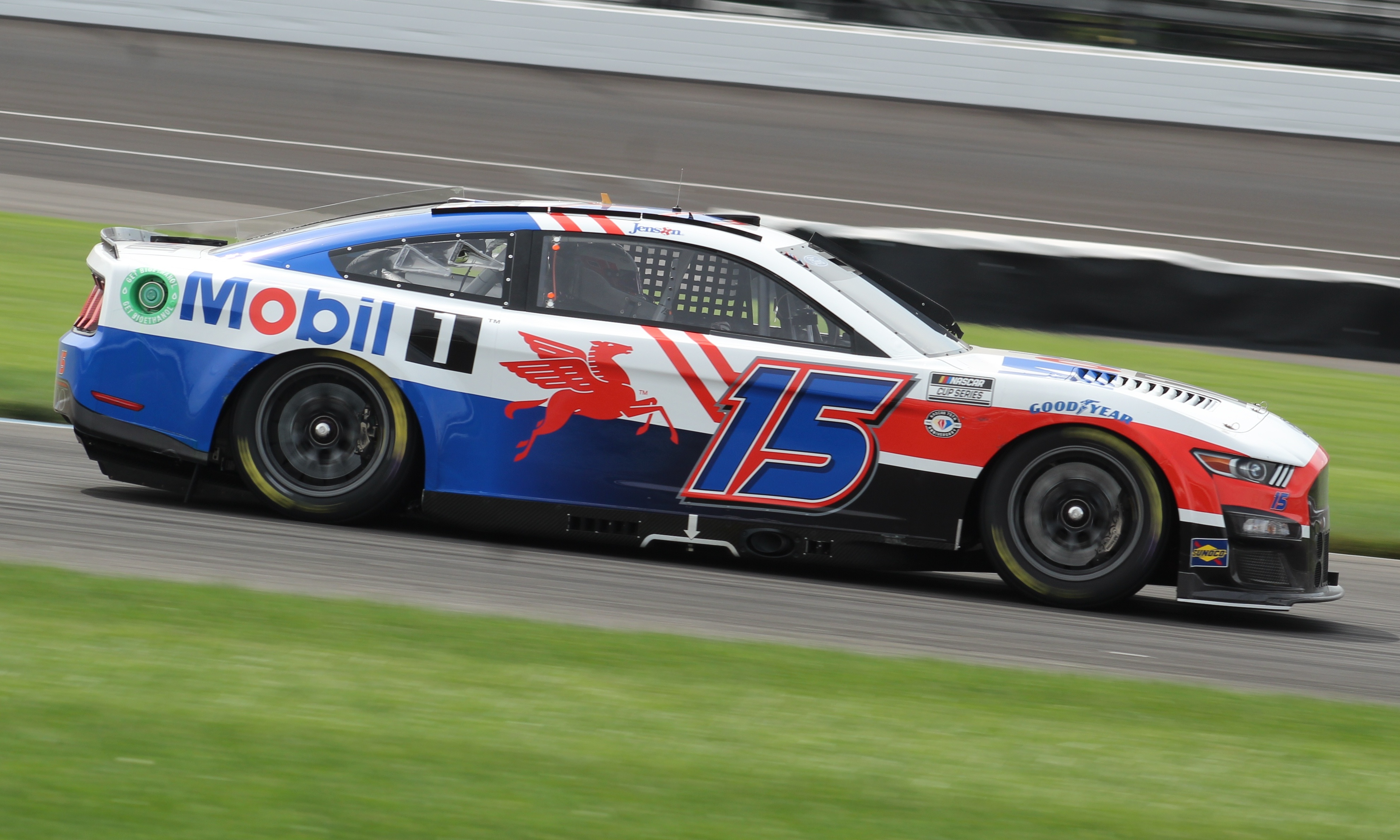
In 2023, Jenson Button competed in three NASCAR Cup Series races for Rick Ware Racing in the No. 15 car, beginning with the 2023 EchoPark Automotive Grand Prix at Circuit of the Americas (COTA). His best result across these three appearances was an 18th-place finish at COTA. Notably, he competed alongside Kamui Kobayashi in the Indianapolis race.
4. Driving style and characteristics
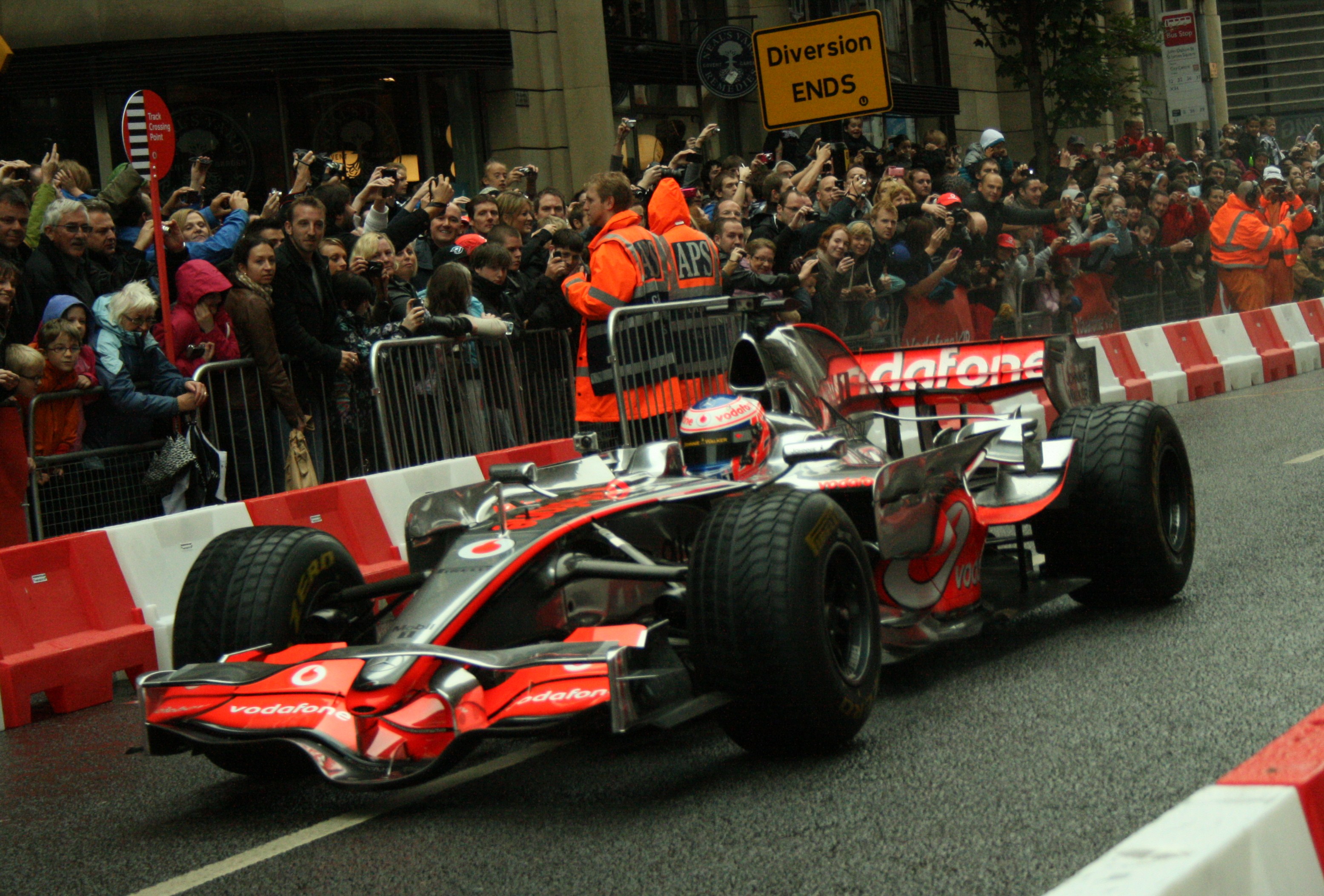
Jenson Button is renowned for his smooth driving style. Journalist Mark Hughes described it in 2009, noting that "Button has a fantastic feel for how much momentum can be taken into a corner and this allows him to be minimal in his inputs-his steering and throttle movements in particular tend to be graceful and beautifully co-ordinated." This particular style allows him to excel in wet weather conditions, where the front of the car typically tends to slide more than the rear. Many observers also believe that his smooth approach helps preserve the tires more effectively during a race. Button developed and adapted this driving style during his early karting career and successfully transferred it to more powerful racing machinery.
Since 2000, Button has utilized left-foot braking, a technique that involves dragging the brake pedal and modulating power to stop the car in less time. He prefers to turn into a corner early under braking and balance the car through precise pedal application and steering. This technique creates more strain in tire loads over a longer physical lap but allows for a higher minimum corner entry speed, which is particularly advantageous for Button in adapting to changeable or slippery track conditions.
Button is comfortable driving a car with understeer and prefers the rear of the car to remain stable both when entering and exiting corners. He rarely locks the inside of his front tires. A consequence of his smooth driving, however, is that he can sometimes struggle to generate the necessary tire temperature on a cool track. Similarly, his gentle steering inputs can produce less energy into the wheel, occasionally preventing his tires from operating efficiently over a single lap in qualifying. His driving style afforded him additional thinking time, making him less prone to errors and improving his overall consistency in races. It also allowed him to anticipate and respond to events on track without necessarily receiving explicit instructions from his team. During the period when traction control was legal in F1 (2001 and 2007), Button demonstrated exceptional throttle control to prevent wheelspin, allowing him to maintain high speeds due to his keen feel for grip when exiting turns.
For the 2014 season, when the FIA introduced a new sporting regulation allowing drivers to select a unique car number for use throughout their F1 career, Button chose the number 22. This number held special significance as it was the car number he was assigned during his 2009 championship-winning season.
5. Personal life
Jenson Button's personal life, a subject of public interest, encompasses his hobbies, relationships, residences, and a notable personal incident.
His hobbies include mountain biking, competing in triathlons, and bodyboarding. Button has a keen interest in triathlons, having participated in various events since 2008. He completed a small race in Sevenoaks, Kent, finishing 16th out of 250 participants, and later finished 117th out of 1,700 competitors at a triathlon in Windsor in June 2008, demonstrating his athleticism. His triathlon team is named "ICHIBAN" (Japanese for "number one" or "first"), a name he has tattooed on his foot and displays on his helmet and uniform. He also enjoys playing PlayStation and has stated that he familiarizes himself with new F1 circuits by trying them out in video games. Button is a fan of the James Bond film franchise, particularly those starring Sean Connery.
Button maintains an automobile collection that includes a 1956 VW Campervan, a Honda S600 (which he received for free when he signed with BAR-Honda in 2003), a Mercedes C63 AMG, and several Ferrari cars, including a Ferrari Enzo. He previously owned a blue Honda NSX Type R and a Bugatti Veyron.
Like many Formula One drivers, Button resides in Monaco. He also has homes in the United Kingdom and Bahrain. He previously lived in Guernsey for 18 months before returning to Monaco in 2012. Despite his celebrity status, Button is known for maintaining a relatively low-key life in the UK, often able to move around London without being pursued by paparazzi.
In terms of relationships, Button was engaged to English actress and singer Louise Griffiths before their five-year relationship ended in May 2005. From 2009 to 2015, he was in a highly publicized relationship with Japanese model Jessica Michibata, whom he married in Hawaii in December 2014. Their marriage, however, lasted only one year, with their divorce being reported in December 2015. Since 2016, Button has been in a relationship with American model Brittny Ward, whom he married in 2022. They have two children, a son and a daughter, and currently reside in Los Angeles. Button is also a supporter of Bristol City Football Club.
On August 3, 2015, Button and Jessica Michibata, along with friends, were burgled at a rented home in Saint-Tropez. Robbers looted the house, stealing belongings worth approximately 300.00 K GBP, including Michibata's 250.00 K GBP engagement ring. Reports suggested that the couple might have been gassed through the air conditioning system prior to the burglars' entry into the building.
6. Endorsements and philanthropy
Jenson Button has leveraged his public profile through various endorsements and has dedicated significant efforts to philanthropic endeavors.
He signed with the BBC to promote its BBCi digital television interactive service from December 2003 to January 2004. Button is a prominent brand ambassador for Head & Shoulders and has appeared in numerous advertising campaigns for the company. His portfolio of brand collaborations also includes Hilton, Hugo Boss, Santander Bank, Tag Heuer, Vodafone, Baylis & Harding, and Hackett London. As a result of his endorsement income and his salary from Mercedes (during his time with Brawn GP and McLaren), Forbes listed him as one of the world's top-earning drivers in motorsports between June 2012 and June 2013. In 2020, Button collaborated with multi-sport brand Dare 2b to launch "AW20," a men's ski range of clothing and accessories. In early 2021, he partnered with car builder Ant Anstead, designer Mark Stubbs, and business adviser Roger Behle to relaunch the luxury coach maker Radford. That same year, he co-founded Coachbilt Whiskey, a premium blended scotch whisky brand, with whisky consultant George Koutsakis. This brand later announced a partnership with Williams Racing in 2024.
Button is also deeply involved in charitable work through the creation of The Jenson Button Trust. Established in March 2010, the Trust selects and nominates a number of charitable beneficiaries to receive funding. He serves as a patron for the Make-A-Wish Foundation UK, granting wishes to terminally ill children and young persons. Button is also a sport ambassador for both The Prince's Trust and the Princess Charlene of Monaco Foundation, and he actively supports the Sean Edwards Foundation. He is part of Johnnie Walker's Join The Pact initiative, promoting responsible drinking. In 2014, following the unexpected death of his father, Button launched the Pink for Papa campaign to raise funds for the Henry Surtees Foundation.
Beyond his racing and endorsements, Button has also pursued business ventures. He owned and operated a restaurant named Victus in Harrogate from 2011 to 2012, though it closed after less than a year. In 2012, he co-founded the sports agency The Sports Partnership with his manager Richard Goodard and public relations officer James Williamson, aiming to provide public relations services and management to the sporting industry. In late 2018, Button, along with Chris Buncombe and team principal Bob Neville, founded the sports car team Jenson Team Rocket RJN. Button has also engaged with media beyond driving; he was on the judging panel for the 2003 UK F1 Drivers' Challenge, broadcast on the Five television program Be A Grand Prix Driver. He also voiced his own character in the animated cartoon series Tooned. Since the 2018 British Grand Prix, Button has served as a pundit for Sky Sports F1, providing analysis for select races, having previously commentated for ITV during the 2005 Monaco Grand Prix when BAR was serving its ban.
7. Public image and recognition
Jenson Button's public image and recognition have evolved throughout his career, marked by fluctuating press attention and numerous accolades. He has received varying degrees of press coverage, ranging from minor to extensive, concerning both his Formula One career and personal life. This phenomenon has occasionally been labeled "Buttonmania." Prior to his 2009 championship victory, his perceived lack of consistent success led some critics to label him "a nearly man" and a "pin-up and lightweight" due to his photogenic appearance. However, such labels largely ceased following his dramatic championship win.
Ben Anderson of Autosport noted that Button "is rarely picked as one of grand prix racing's true elite drivers" and is not typically "discussed in the same breath as those, such as Schumacher and Ayrton Senna." Anderson suggested this might be due to "a lack of absolute dynamism behind the wheel in difficult technical circumstances - perhaps holds him back from being regarded as among the true elite." Writing for The New York Times, Brad Spurgeon observed that Button's F1 debut initiated a trend of teams signing young drivers, highlighting the intense scrutiny they would face regarding pressure, performance, and media interactions in the championship. Andrew Benson of BBC Sport described Button as "urbane and eloquent. Good-looking and charismatic, he is a marketing person's dream, and has a ready wit that can edge into sarcasm if he is impatient or uncomfortable with a situation."
Button has received numerous awards and honors throughout his career:
- In 2009, he finished second to footballer Ryan Giggs in voting for the BBC Sports Personality of the Year Award, having previously been nominated for the award three years prior. He did, however, win the BBC West Country's Sports Personality of the Year and the Laureus World Breakthrough of the Year award.
- In 2000, he won the BBC Sports Personality of the Year Newcomer Award for finishing eighth in his debut F1 season.
- He received the Lorenzo Bandini Trophy in 2001.
- Button earned the Hawthorn Memorial Trophy as the most successful British or Commonwealth driver in a season five times: in 2004, 2005, 2006, 2009, and 2011.
- He was voted the Autosport Rookie of the Year in 2000.
- He won the International Racing Driver Award in 2004 and 2009.
- He was recognized as the British Competition Driver of the Year in 2003, 2009, 2011, and 2012.
- Button received the BRDC Gold Star in 2004 and 2009.
- In 2017, he was inducted into the FIA Hall of Fame.
- Button was appointed Member of the Order of the British Empire (MBE) in the 2010 New Year Honours for his services to motorsport.
- His hometown of Frome has honored him by naming a street and a footbridge over the River Frome after him, and has also awarded him the freedom of the town.
- In December 2016, he received an honorary doctorate in engineering from the University of Bath.
- Button has authored five books about his life and career: My Life on The Formula One Rollercoaster (ghostwritten by David Tremayne in 2002), My World (2007), My Championship Year (2009), Life to The Limit (2017), and How to be an F1 Driver (2019).
- His 2009 championship-winning season and Brawn GP's remarkable rise to success are the central focus of the Disney+ miniseries Brawn: The Impossible Formula 1 Story in 2023, starring Keanu Reeves as Ross Brawn.
8. Relationship with Japan
Jenson Button has a particularly special and deep connection with Japanese motorsport and culture.
Button is well-known in the motorsport community for his strong affection for Japan. He has frequently expressed his special feelings for the country, partly due to his long history competing with Honda-powered teams in Formula One and later in Super GT. His marriage to Japanese national Jessica Michibata further cemented this connection. He has collaborated extensively with Japanese racing teams, including Team Kunimitsu and Team Mugen in the Super GT series. Button has also often used Japanese phrases, such as "頑張りますGanbarimasuJapanese" (I'll do my best) and "やったー!Yatta!Japanese" (Yay!), and actively shares videos of his experiences both on and off the track in Japan on his YouTube channel.
His affinity for Japan was particularly evident during the aftermath of the 2011 Tōhoku earthquake and tsunami. Button sent a message to the victims, expressing his shock at the tragedy and his concern for the people of Japan, especially those in the heavily affected area of Sendai. After the 2011 Chinese Grand Prix, he even traveled to Japan to assist with the relief efforts organized by Jessica Michibata.
In his Formula One career, Button demonstrated remarkable consistency at Japanese circuits. From his debut in 2000 until his last full season in 2016, he never retired from the Japanese Grand Prix, always completing the race (including classified finishes). Similarly, he completed every Chinese Grand Prix he entered. Button was also reportedly in line to be the owner of the first HondaJet, Honda's entry into the aviation industry, though this plan was cancelled following Honda's withdrawal from Formula One.
9. Career statistics
9.1. Karting career summary
| Season | Series | Team | Position |
|---|---|---|---|
| 1991 | Super 1 National Championship - IAME Cadet | Wright Karts | 1st |
| 1992 | ABkC 'O' Plate - Junior TKM | 1st | |
| 1994 | Trofeo Andrea Margutti - 100cc Junior | 16th | |
| Torneo delle Industrie - 100cc Junior | 8th | ||
| 1995 | Trofeo Andrea Margutti - ICA | 5th | |
| World Championship - Senior | 2nd | ||
| 1996 | Trofeo Andrea Margutti - Formula A | 32nd | |
| World Cup - Formula A | 3rd | ||
| World Championship - Senior | 32nd | ||
| WKA North American Championship - Formula A | 3rd | ||
| 1997 | Trofeo Andrea Margutti - Formula A | 10th | |
| European Championship - Formula Super A | 1st | ||
| World Cup - Formula Super A | 27th | ||
| World Championship - Formula Super A | 27th |
9.2. Career summary
| Season | Series | Team | Races | Wins | Poles | F/Laps | Podiums | Points | Position |
|---|---|---|---|---|---|---|---|---|---|
| 1998 | British Formula Ford Championship | Haywood Racing | 15 | 7 | 9 | 7 | 12 | 133 | 1st |
| European Formula Ford Championship | Haywood Racing | 4 | 1 | 2 | 2 | 2 | 47 | 2nd | |
| Formula Ford Festival | Haywood Racing | 1 | 1 | 0 | 0 | 1 | N/A | 1st | |
| 1999 | British Formula 3 Championship | Promatecme UK | 16 | 3 | 3 | 4 | 7 | 168 | 3rd |
| Masters of Formula 3 | Promatecme UK | 1 | 0 | 0 | 0 | 0 | N/A | 5th | |
| Macau Grand Prix | Promatecme UK | 1 | 0 | 0 | 0 | 1 | N/A | 2nd | |
| Korea Super Prix | Promatecme UK | 1 | 0 | 0 | 0 | 1 | N/A | 2nd | |
| Spa 24 Hours | BMW FINA Team Rafanelli | 1 | 0 | 0 | 0 | 0 | 0 | NC | |
| 2000 | Formula One | BMW WilliamsF1 Team | 17 | 0 | 0 | 0 | 0 | 12 | 8th |
| 2001 | Formula One | Mild Seven Benetton Renault | 17 | 0 | 0 | 0 | 0 | 2 | 17th |
| 2002 | Formula One | Mild Seven Renault F1 Team | 17 | 0 | 0 | 0 | 0 | 14 | 7th |
| 2003 | Formula One | Lucky Strike BAR Honda | 15 | 0 | 0 | 0 | 0 | 17 | 9th |
| 2004 | Formula One | Lucky Strike BAR Honda | 18 | 0 | 1 | 0 | 10 | 85 | 3rd |
| 2005 | Formula One | Lucky Strike BAR Honda | 16 | 0 | 1 | 0 | 2 | 37 | 9th |
| 2006 | Formula One | Lucky Strike Honda Racing F1 Team | 18 | 1 | 1 | 0 | 3 | 56 | 6th |
| 2007 | Formula One | Honda Racing F1 Team | 17 | 0 | 0 | 0 | 0 | 6 | 15th |
| 2008 | Formula One | Honda Racing F1 Team | 18 | 0 | 0 | 0 | 0 | 3 | 18th |
| 2009 | Formula One | Brawn GP F1 Team | 17 | 6 | 4 | 2 | 9 | 95 | 1st |
| 2010 | Formula One | Vodafone McLaren Mercedes | 19 | 2 | 0 | 1 | 7 | 214 | 5th |
| 2011 | Formula One | Vodafone McLaren Mercedes | 19 | 3 | 0 | 3 | 12 | 270 | 2nd |
| 2012 | Formula One | Vodafone McLaren Mercedes | 20 | 3 | 1 | 2 | 6 | 188 | 5th |
| 2013 | Formula One | Vodafone McLaren Mercedes | 19 | 0 | 0 | 0 | 0 | 73 | 9th |
| 2014 | Formula One | McLaren Mercedes | 19 | 0 | 0 | 0 | 1 | 126 | 8th |
| 2015 | Formula One | McLaren Honda | 19 | 0 | 0 | 0 | 0 | 16 | 16th |
| 2016 | Formula One | McLaren Honda | 21 | 0 | 0 | 0 | 0 | 21 | 15th |
| 2017 | Formula One | McLaren Honda | 1 | 0 | 0 | 0 | 0 | 0 | NC |
| Super GT - GT500 | Team Mugen | 1 | 0 | 0 | 0 | 0 | 0 | NC | |
| 2018 | Super GT - GT500 | Team Kunimitsu | 8 | 1 | 1 | 0 | 4 | 78 | 1st |
| 24 Hours of Le Mans - LMP1 | SMP Racing | 1 | 0 | 0 | 0 | 0 | N/A | DNF | |
| 2018-19 | FIA World Endurance Championship - LMP1 | SMP Racing | 4 | 0 | 0 | 0 | 1 | 27 | 15th |
| 2019 | Super GT - GT500 | Team Kunimitsu | 8 | 0 | 0 | 0 | 2 | 37 | 8th |
| Deutsche Tourenwagen Masters | Team Kunimitsu | 2 | 0 | 0 | 0 | 0 | 0 | NC† | |
| 2020 | British GT Championship - GT3 | Jenson Team Rocket RJN | 1 | 0 | 0 | 0 | 0 | 0 | NC† |
| 2021 | Extreme E | JBXE | 1 | 0 | 0 | 0 | 0 | 17 | 12th |
| 2022-23 | Nitro Rallycross Championship | Xite Energy Racing | 1 | 0 | 0 | 0 | 0 | 21 | 17th |
| 2023 | NASCAR Cup Series | Rick Ware Racing | 3 | 0 | 0 | 0 | 0 | 45 | 35th |
| IMSA SportsCar Championship - GTP | JDC-Miller MotorSports | 1 | 0 | 0 | 0 | 0 | 282 | 23rd | |
| 24 Hours of Le Mans | Hendrick Motorsports | 1 | 0 | 0 | 0 | 0 | N/A | 39th | |
| 2024 | FIA World Endurance Championship - Hypercar | Hertz Team Jota | 8 | 0 | 0 | 0 | 0 | 28 | 19th |
| 24 Hours of Le Mans | Hertz Team Jota | 1 | 0 | 0 | 0 | 0 | N/A | 9th | |
| IMSA SportsCar Championship - GTP | Wayne Taylor Racing with Andretti | 1 | 0 | 0 | 0 | 1 | 326 | 25th | |
| 2025 | FIA World Endurance Championship - Hypercar | Cadillac Hertz Team Jota | 0 | 0 | 0 | 0 | 0 | 0 | * |
† As Button was a guest driver, he was ineligible to score championship points.
- Season still in progress.
9.3. British Formula 3 Championship results
(Races in bold indicate pole position) (Races in italics indicate fastest lap)
| Year | Entrant | Engine | Class | 1 | 2 | 3 | 4 | 5 | 6 | 7 | 8 | 9 | 10 | 11 | 12 | 13 | 14 | 15 | 16 | Drivers' Championship rank | Points |
|---|---|---|---|---|---|---|---|---|---|---|---|---|---|---|---|---|---|---|---|---|---|
| 1999 | Promatecme UK | Renault Sodemo | A | DON | SIL | THR | BRH | BRH | OUL | CRO | BRH | SIL | SNE | PEM | PEM | DON | SPA | SIL | THR | 3rd | 168 |
9.4. Spa 24 Hours results
| Year | Team | Co-Drivers | Car | Class | Laps completed | Position | Class |
|---|---|---|---|---|---|---|---|
| 1999 | BMW FINA Team Rafanelli | David Saelens | BMW 320i E46 | SP | 22 | DNF | DNF |
9.5. Complete Formula One results
(Races in bold indicate pole position; races in italics indicate fastest lap; small number denotes the finishing position)
{| class="wikitable"
! scope="col" | Year
! scope="col" | Entrant
! scope="col" | Chassis
! scope="col" | Engine
! scope="col" | 1
! scope="col" | 2
! scope="col" | 3
! scope="col" | 4
! scope="col" | 5
! scope="col" | 6
! scope="col" | 7
! scope="col" | 8
! scope="col" | 9
! scope="col" | 10
! scope="col" | 11
! scope="col" | 12
! scope="col" | 13
! scope="col" | 14
! scope="col" | 15
! scope="col" | 16
! scope="col" | 17
! scope="col" | 18
! scope="col" | 19
! scope="col" | 20
! scope="col" | 21
! scope="col" | World Drivers' Championship position
! scope="col" | Points
|-
| 2000
! BMW WilliamsF1 Team
! Williams FW22
! BMW E41 3.0 V10
| AUS
Ret
| BRA
6
| SMR
Ret
| GBR
5
| ESP
17†
| EUR
10†
| MON
Ret
| CAN
11
| FRA
8
| AUT
5
| GER
4
| HUN
9
| BEL
5
| ITA
Ret
| USA
Ret
| JPN
5
| MAL
Ret
|colspan=4|
! 8th
! 12
|-
| 2001
! Benetton Formula
! Benetton B201
! Renault RS21 3.0 V10
| AUS
14†
| MAL
11
| BRA
10
| SMR
12
| ESP
15
| AUT
Ret
| MON
7
| CAN
Ret
| EUR
13
| FRA
16†
| GBR
15
| GER
5
| HUN
Ret
| BEL
Ret
| ITA
Ret
| USA
9
| JPN
7
|colspan=4|
! 17th
! 2
|-
| 2002
! Mild Seven Renault F1 Team
! Renault R202
! Renault RS22 3.0 V10
| AUS
Ret
| MAL
4
| BRA
4
| SMR
5
| ESP
12†
| AUT
7
| MON
Ret
| CAN
15†
| EUR
5
| GBR
12†
| FRA
6
| GER
Ret
| HUN
Ret
| BEL
Ret
| ITA
5
| USA
8
| JPN
6
|colspan=4|
! 7th
! 14
|-
| 2003
! Lucky Strike BAR Honda
! BAR 005
! Honda RA003E 3.0 V10
| AUS
10
| MAL
7
| BRA
Ret
| SMR
8
| ESP
9
| AUT
4
| MON
DNS
| CAN
Ret
| EUR
7
| FRA
Ret
| GBR
8
| GER
8
| HUN
10
| ITA
Ret
| USA
Ret
| JPN
4
|colspan=5|
! 9th
! 17
|-
| 2004
! Lucky Strike BAR Honda
! BAR 006
! Honda RA004E 3.0 V10
| AUS
6
| MAL
3
| BHR
3
| SMR
2
| ESP
8
| MON
2
| EUR
3
| CAN
3
| USA
Ret
| FRA
5
| GBR
4
| GER
2
| HUN
5
| BEL
Ret
| ITA
3
| CHN
2
| JPN
3
| BRA
Ret
|colspan=3|
! 3rd
! 85
|-
| 2005
! Lucky Strike BAR Honda
! BAR 007
! Honda RA005E 3.0 V10
| AUS
11†
| MAL
Ret
| BHR
Ret
| SMR
DSQ
| ESP
| MON
| EUR
10
| CAN
Ret
| USA
DNS
| FRA
4
| GBR
5
| GER
3
| HUN
5
| TUR
5
| ITA
8
| BEL
3
| BRA
7
| JPN
5
| CHN
8
|colspan=2|
! 9th
! 37
|-
| 2006
! Lucky Strike Honda Racing F1 Team
! Honda RA106
! Honda RA806E 2.4 V8
| BHR
4
| MAL
3
| AUS
10†
| SMR
7
| EUR
Ret
| ESP
6
| MON
11
| GBR
Ret
| CAN
9
| USA
Ret
| FRA
Ret
| GER
4
| HUN
1
| TUR
4
| ITA
5
| CHN
4
| JPN
4
| BRA
3
|colspan=3|
! 6th
! 56
|-
| 2007
! Honda Racing F1 Team
! Honda RA107
! Honda RA807E 2.4 V8
| AUS
15
| MAL
12
| BHR
Ret
| ESP
12
| MON
11
| CAN
Ret
| USA
12
| FRA
8
| GBR
10
| EUR
Ret
| HUN
Ret
| TUR
13
| ITA
8
| BEL
Ret
| JPN
11†
| CHN
5
| BRA
Ret
|colspan=4|
! 15th
! 6
|-
| 2008
! Honda Racing F1 Team
! Honda RA108
! Honda RA808E 2.4 V8
| AUS
Ret
| MAL
10
| BHR
Ret
| ESP
6
| TUR
11
| MON
11
| CAN
11
| FRA
Ret
| GBR
Ret
| GER
17
| HUN
12
| EUR
13
| BEL
15
| ITA
15
| SIN
9
| JPN
14
| CHN
16
| BRA
13
|colspan=3|
! 18th
! 3
|-
| 2009
! Brawn GP F1 Team
! Brawn BGP 001
! Mercedes FO 108W 2.4 V8
| AUS
1
| MAL
1‡
| CHN
3
| BHR
1
| ESP
1
| MON
1
| TUR
1
| GBR
6
| GER
5
| HUN
7
| EUR
7
| BEL
Ret
| ITA
2
| SIN
5
| JPN
8
| BRA
5
| ABU
3
|colspan=4|
! 1st
! 95
|-
| 2010
! Vodafone McLaren Mercedes
! McLaren MP4-25
! Mercedes FO 108X 2.4 V8
| BHR
7
| AUS
1
| MAL
8
| CHN
1
| ESP
5
| MON
Ret
| TUR
2
| CAN
2
| EUR
3
| GBR
4
| GER
5
| HUN
8
| BEL
Ret
| ITA
2
| SIN
4
| JPN
4
| KOR
12
| BRA
5
| ABU
3
|colspan=2|
! 5th
! 214
|-
| 2011
! Vodafone McLaren Mercedes
! McLaren MP4-26
! Mercedes FO 108Y 2.4 V8
| AUS
6
| MAL
2
| CHN
4
| TUR
6
| ESP
3
| MON
3
| CAN
1
| EUR
6
| GBR
Ret
| GER
Ret
| HUN
1
| BEL
3
| ITA
2
| ''[[2011 Singapore Grand Prix|